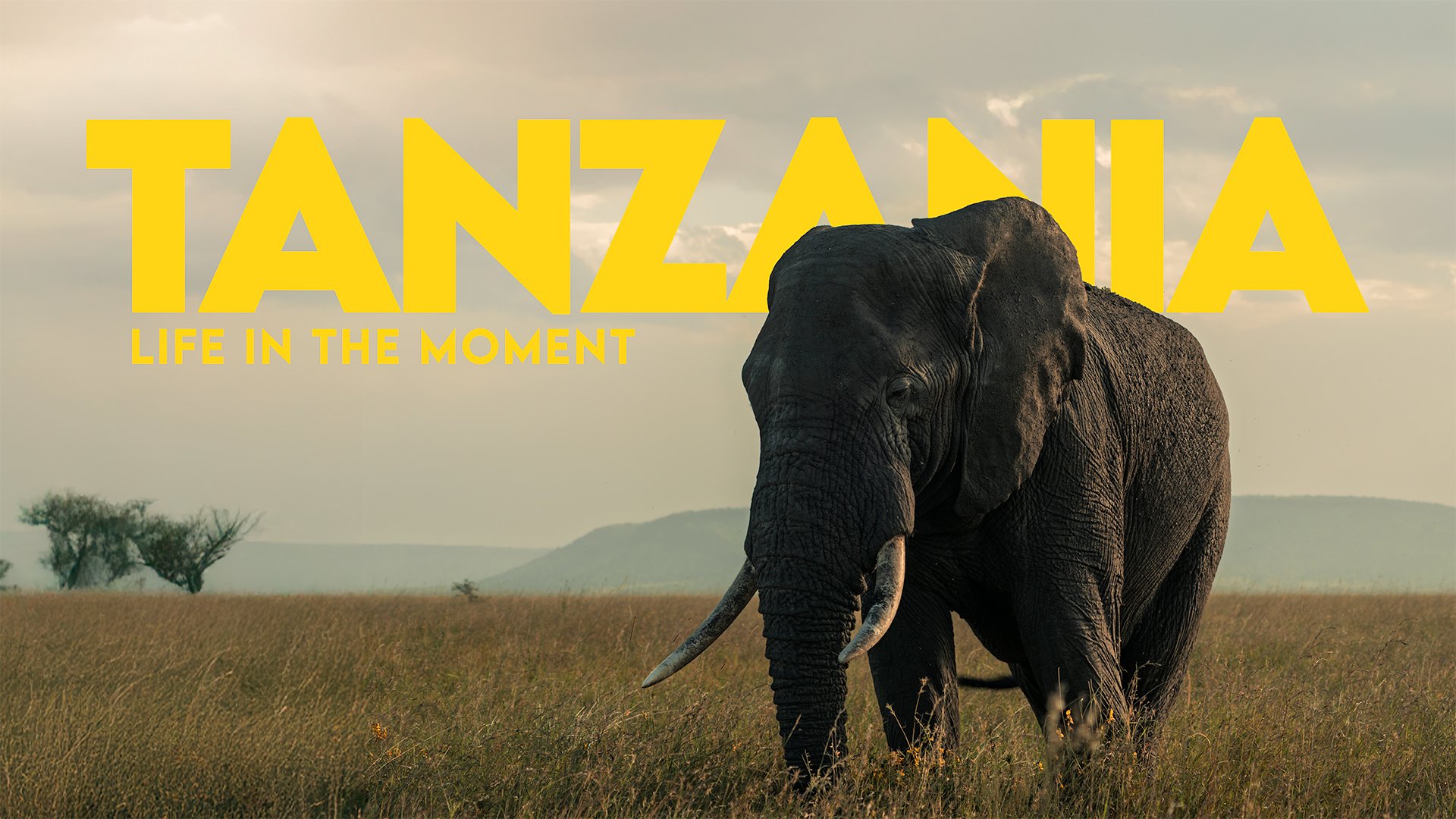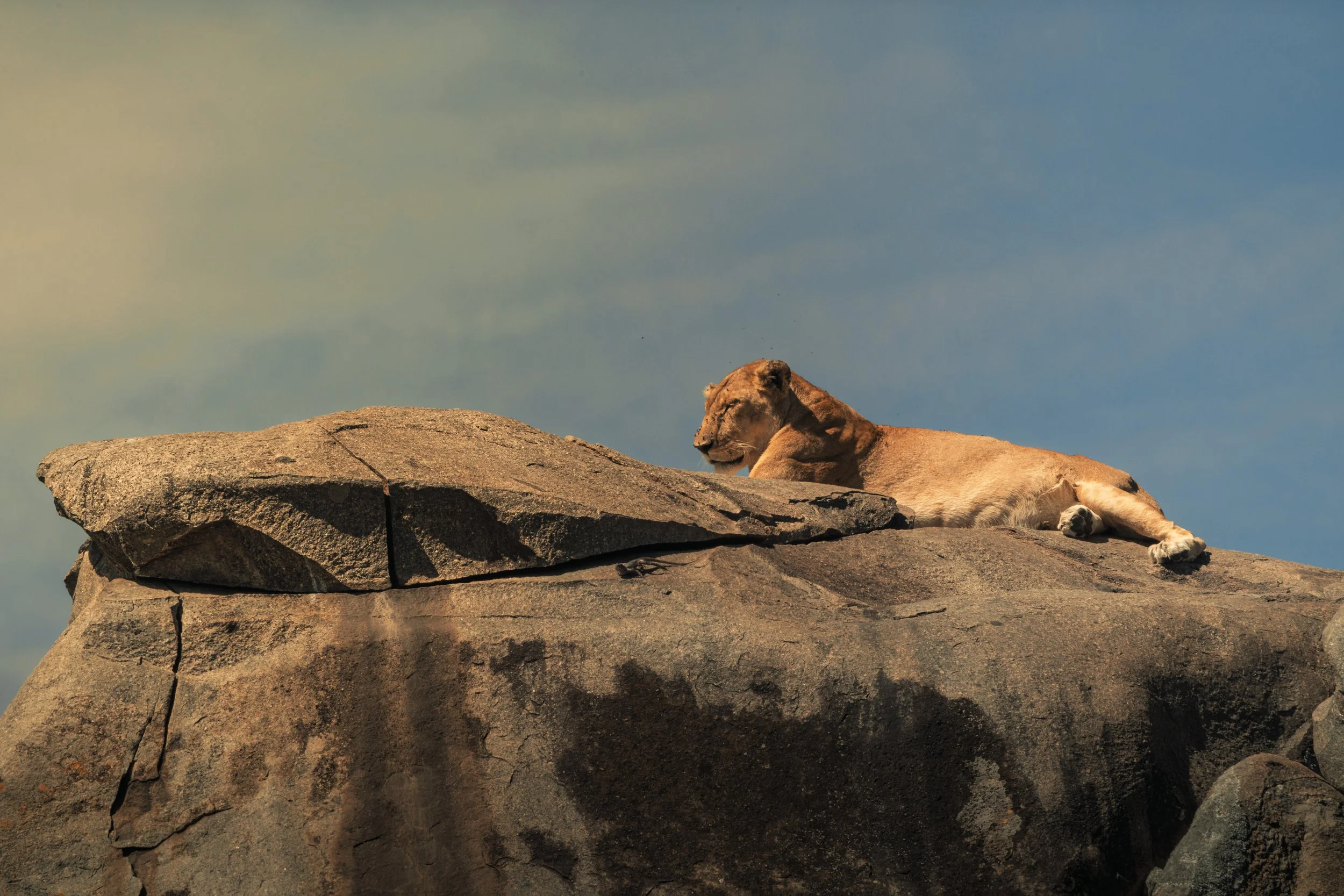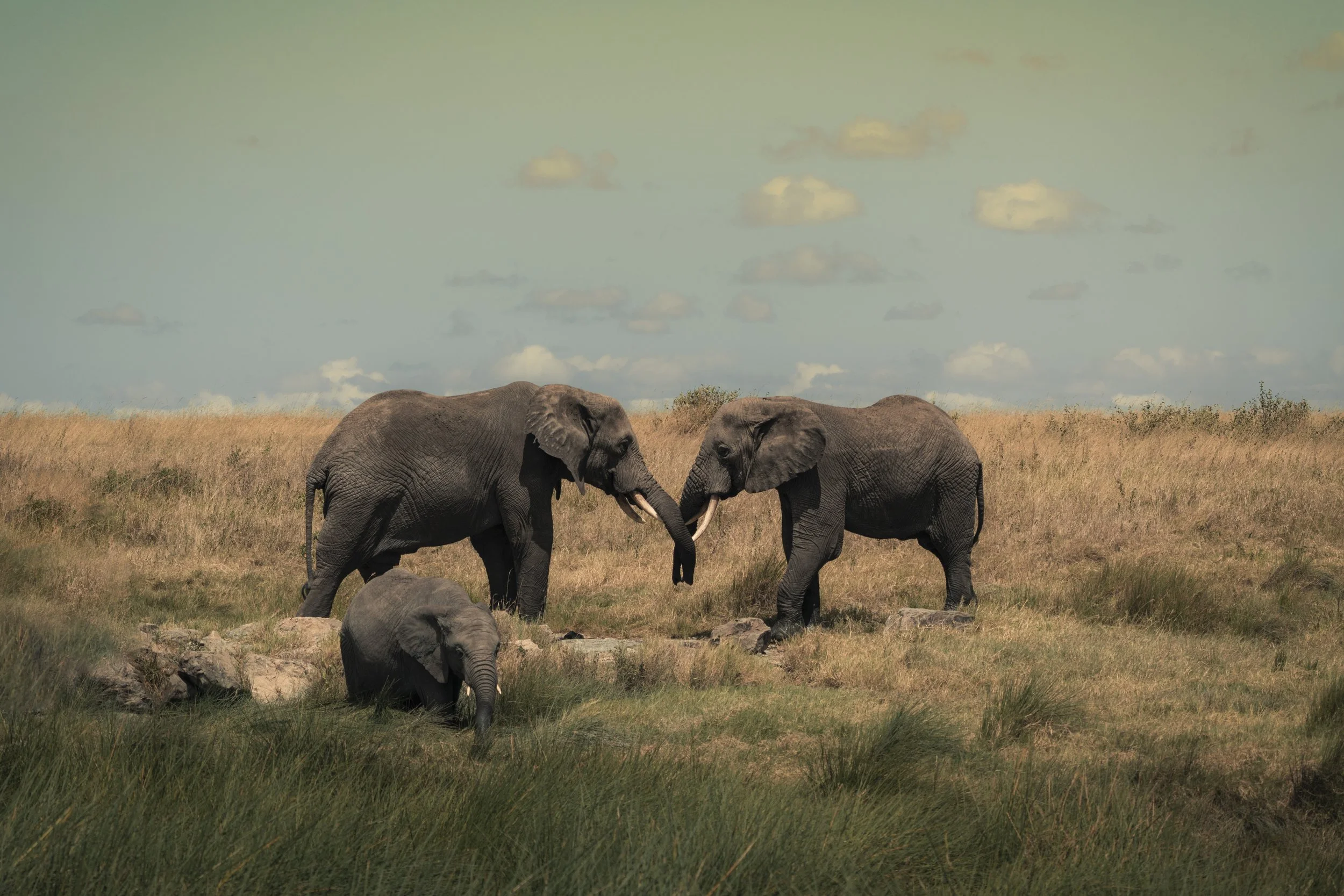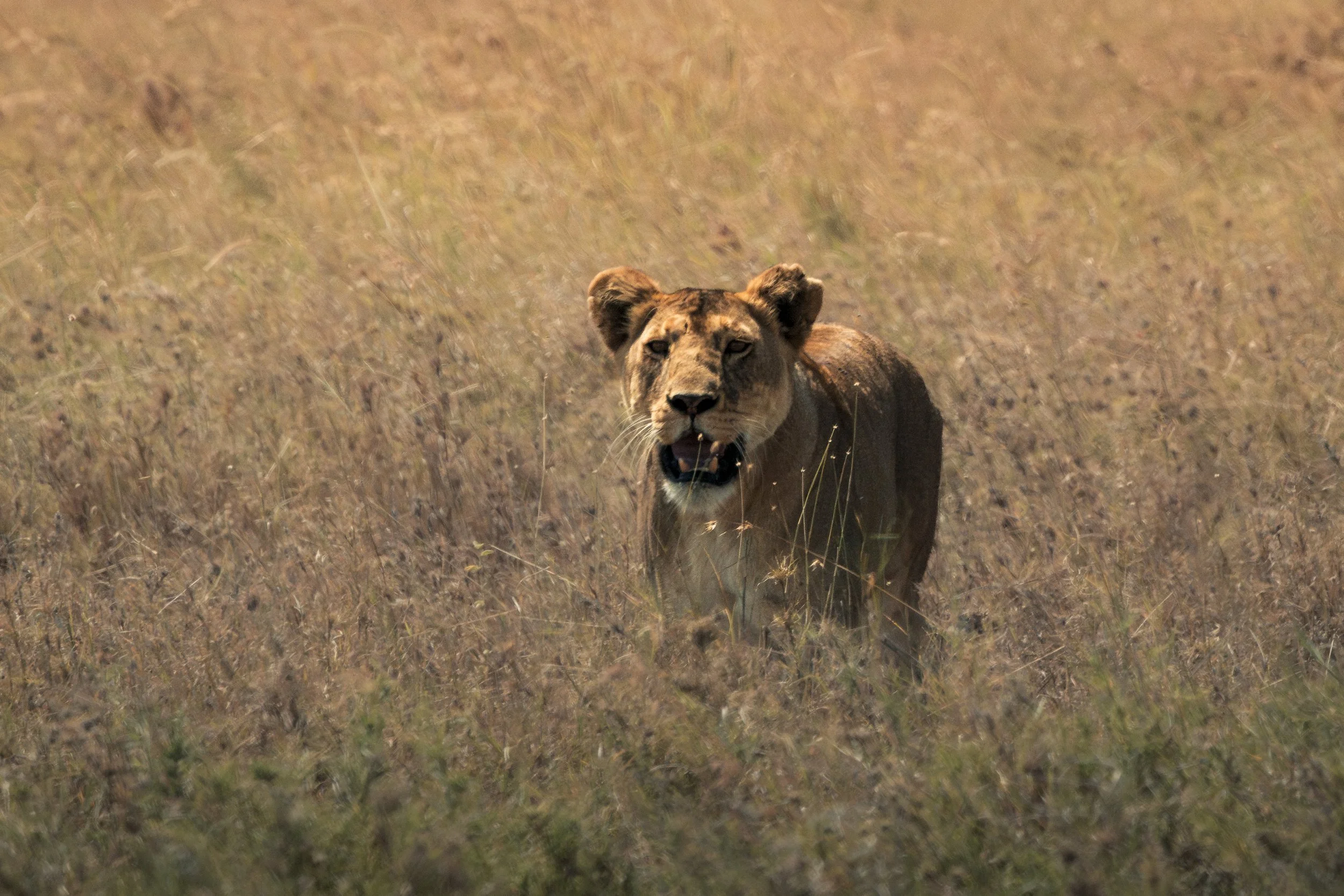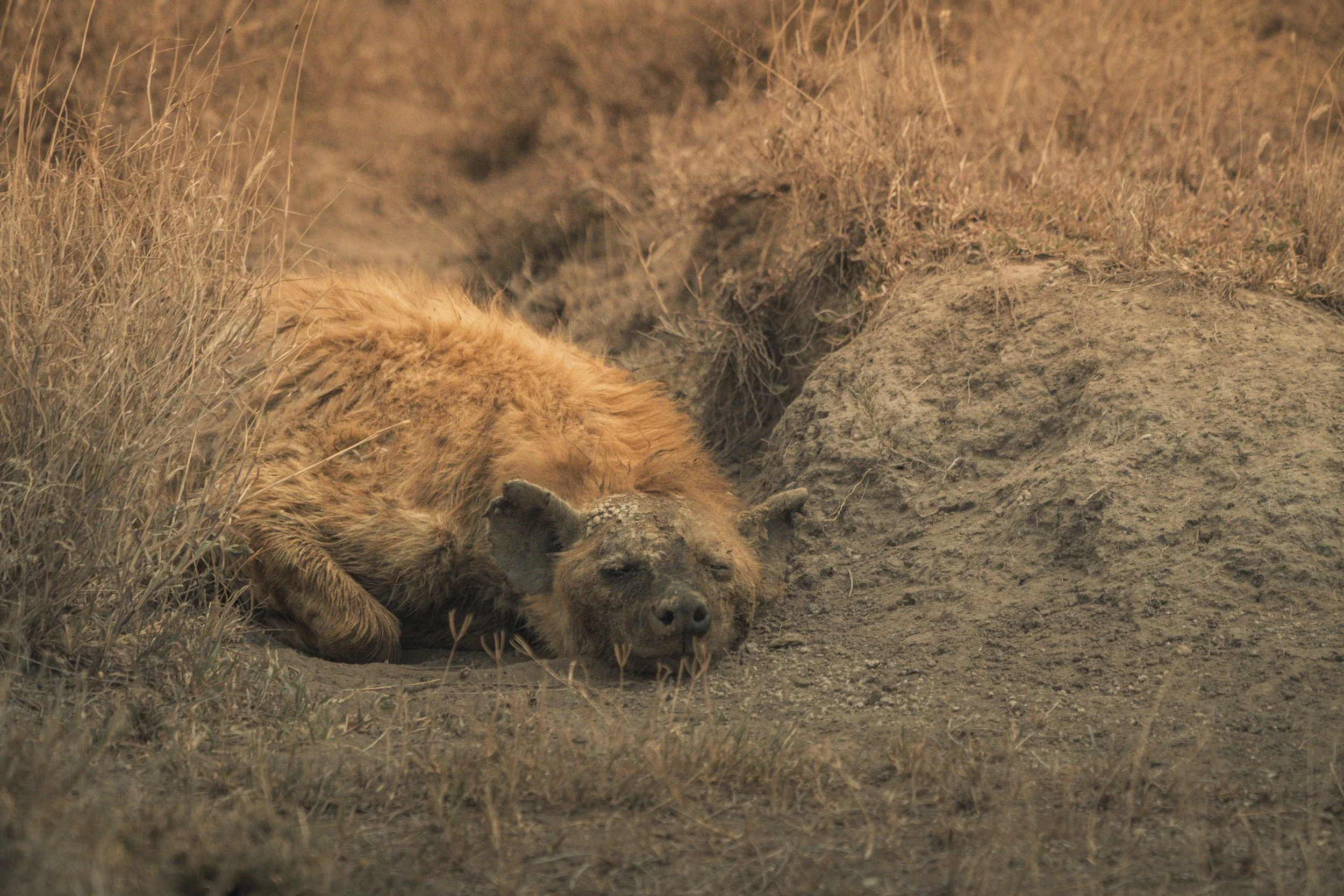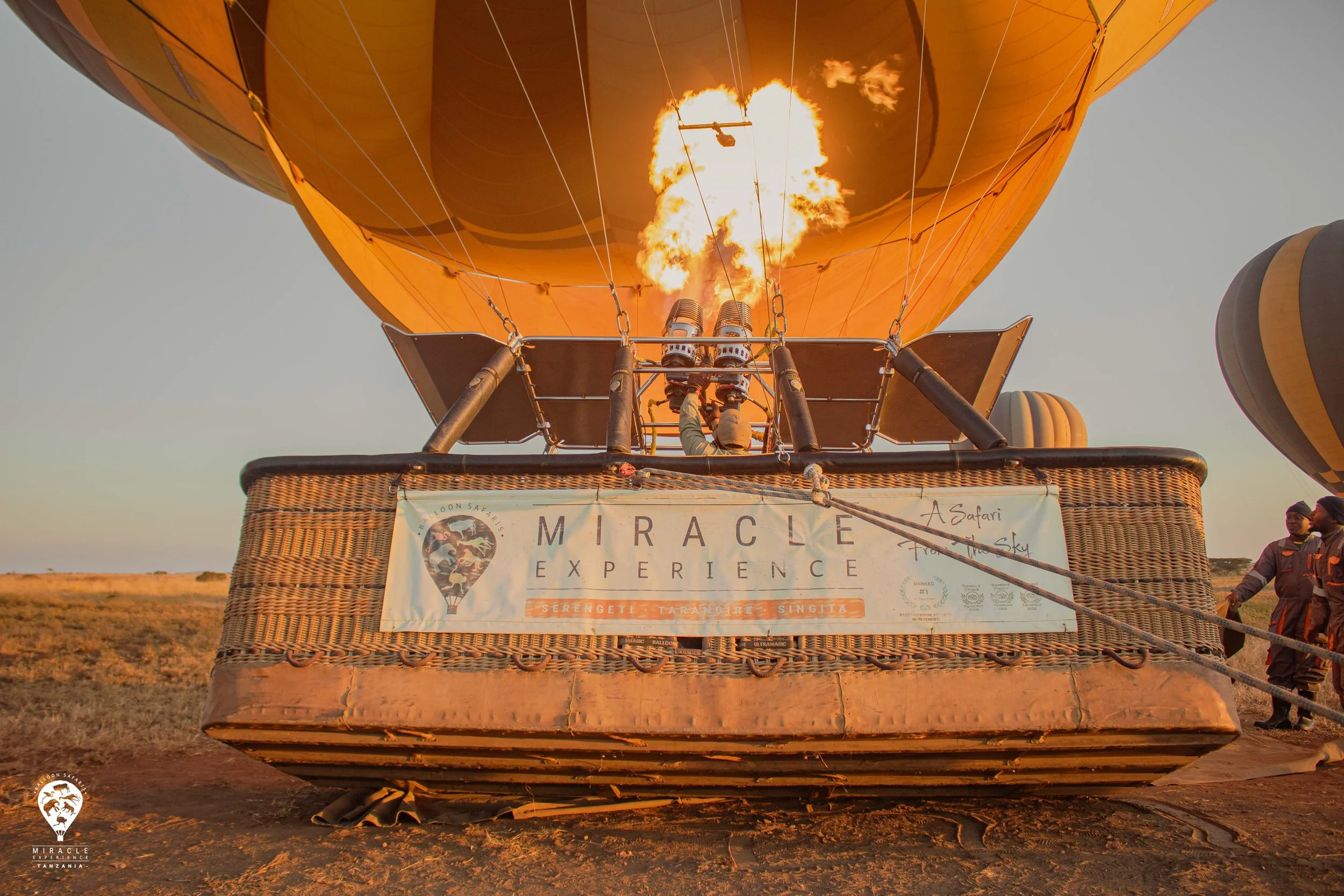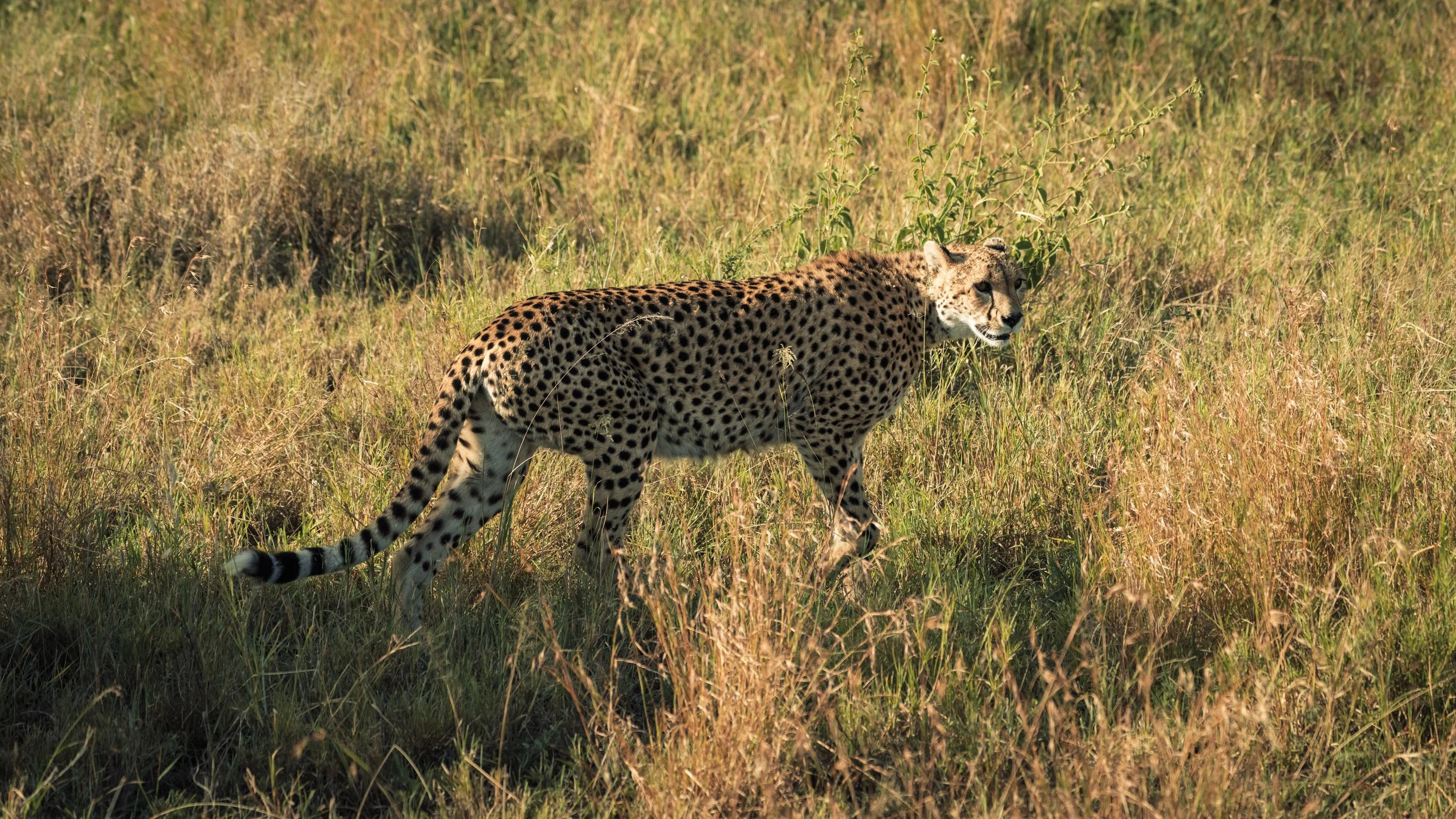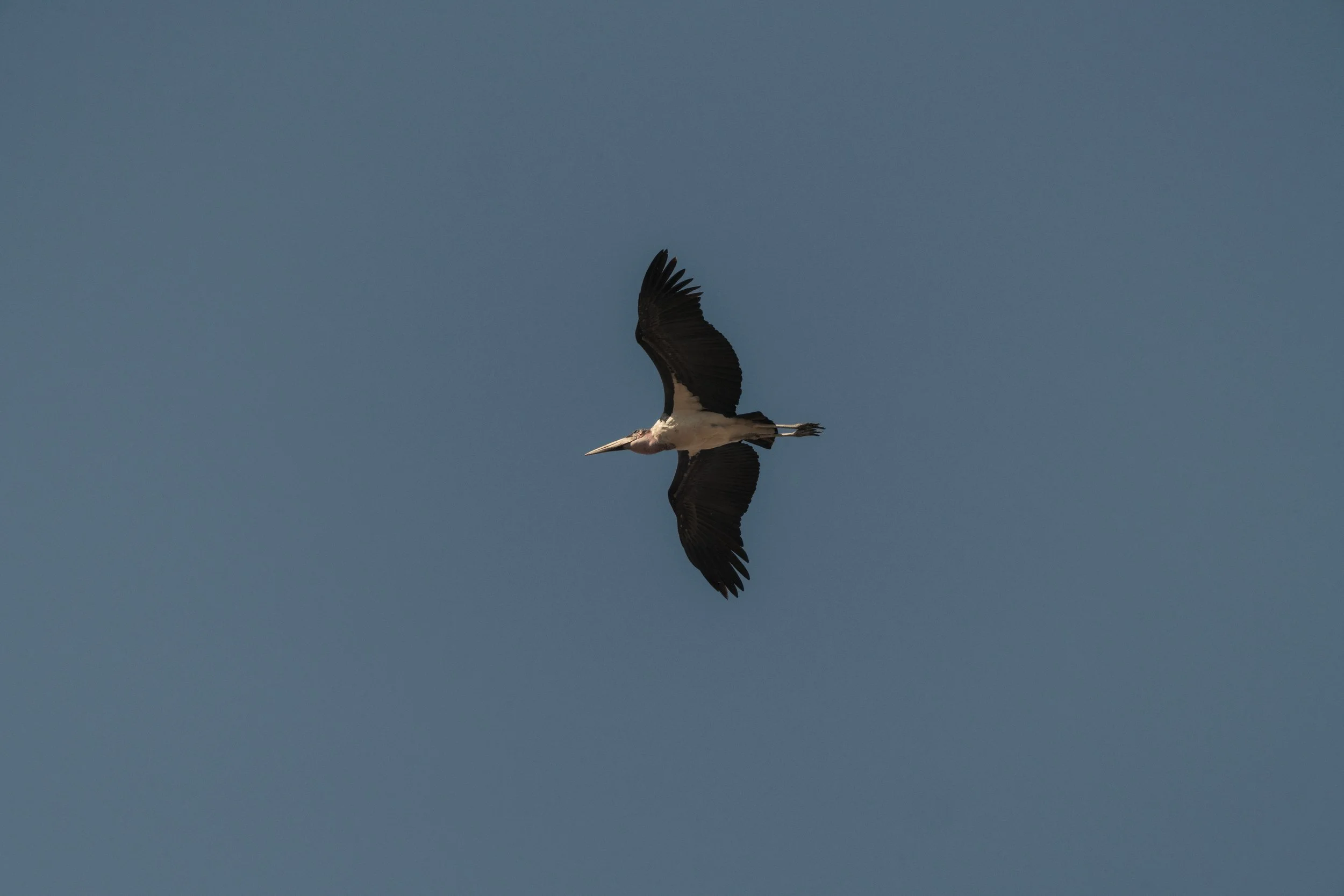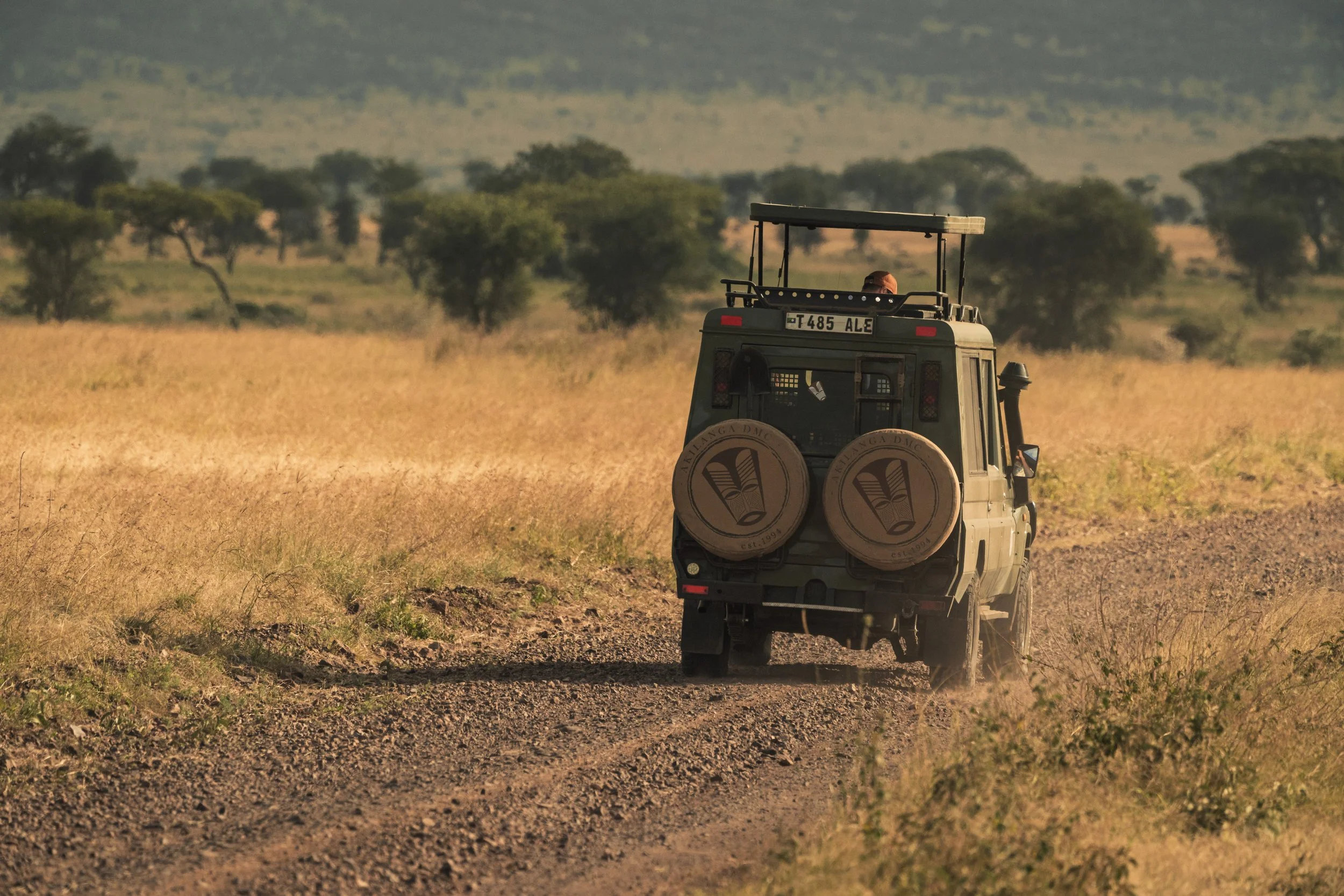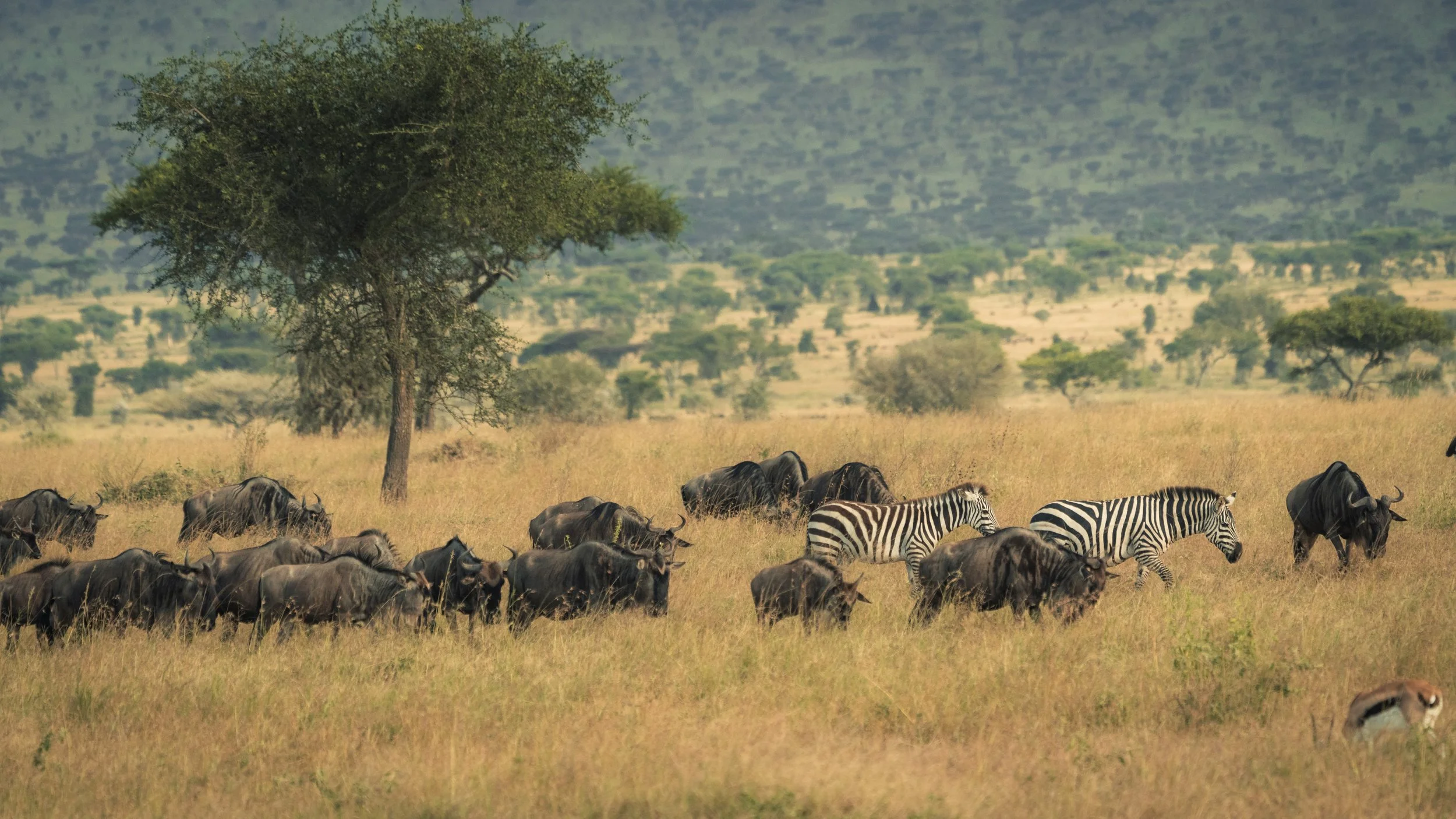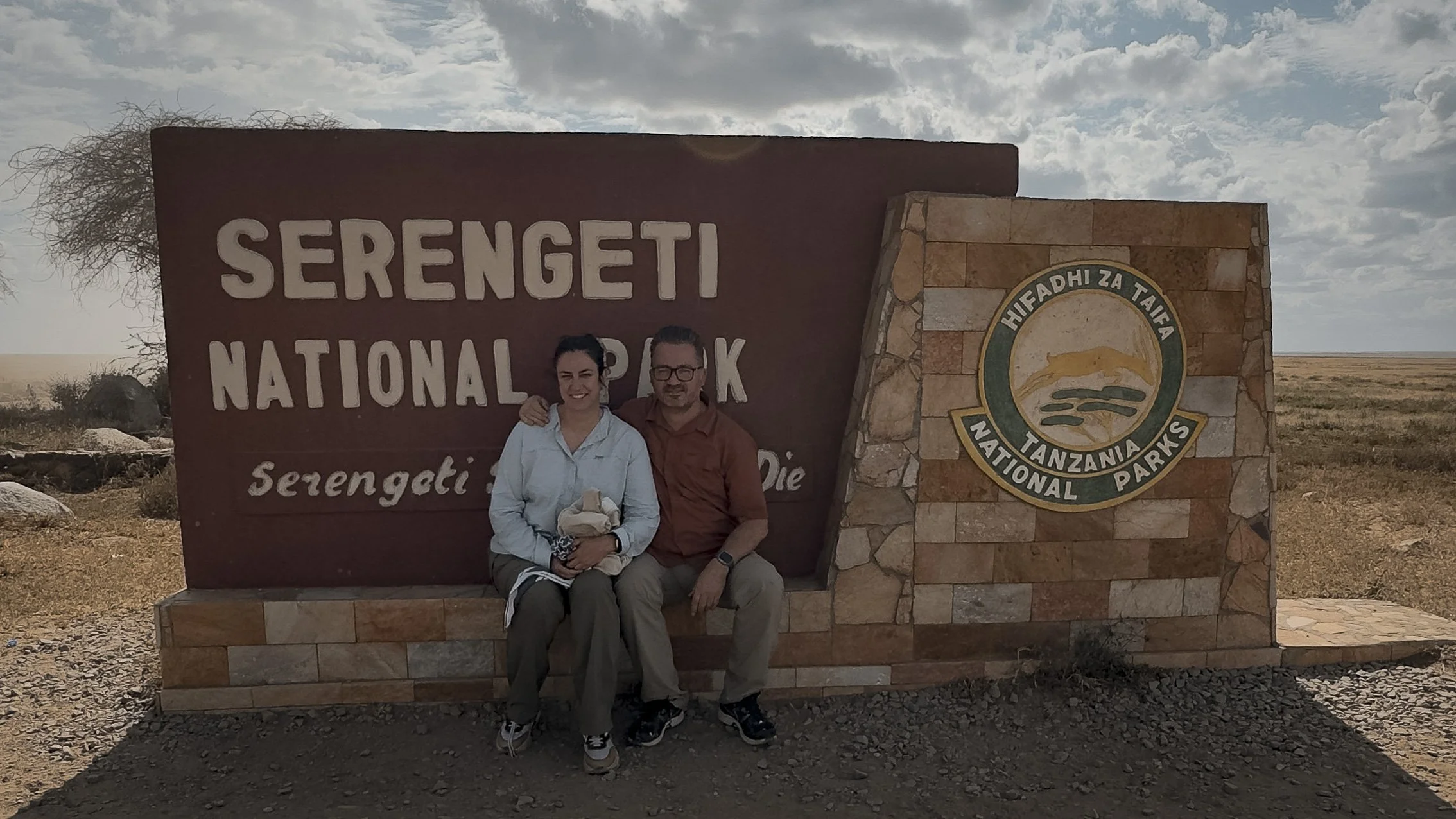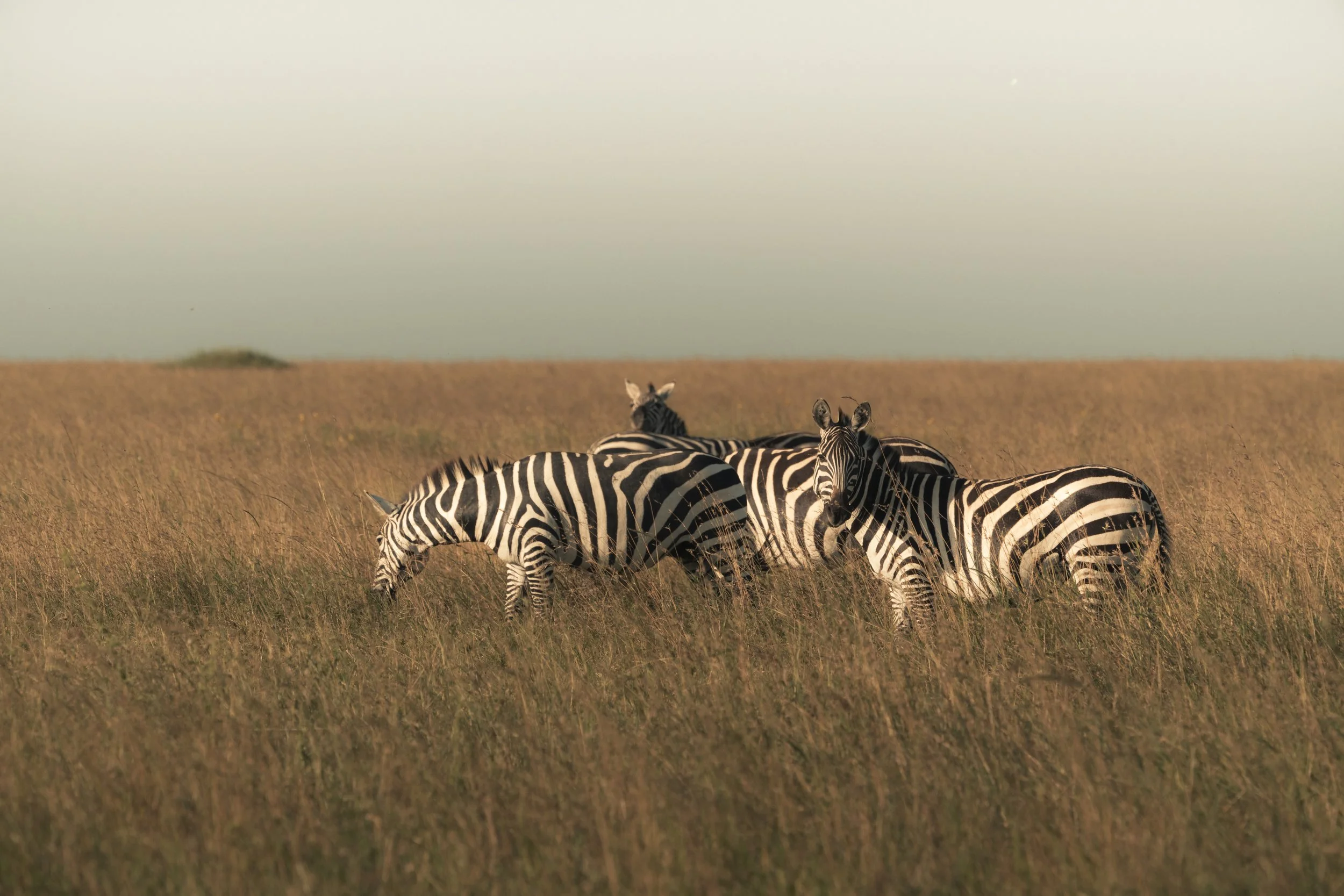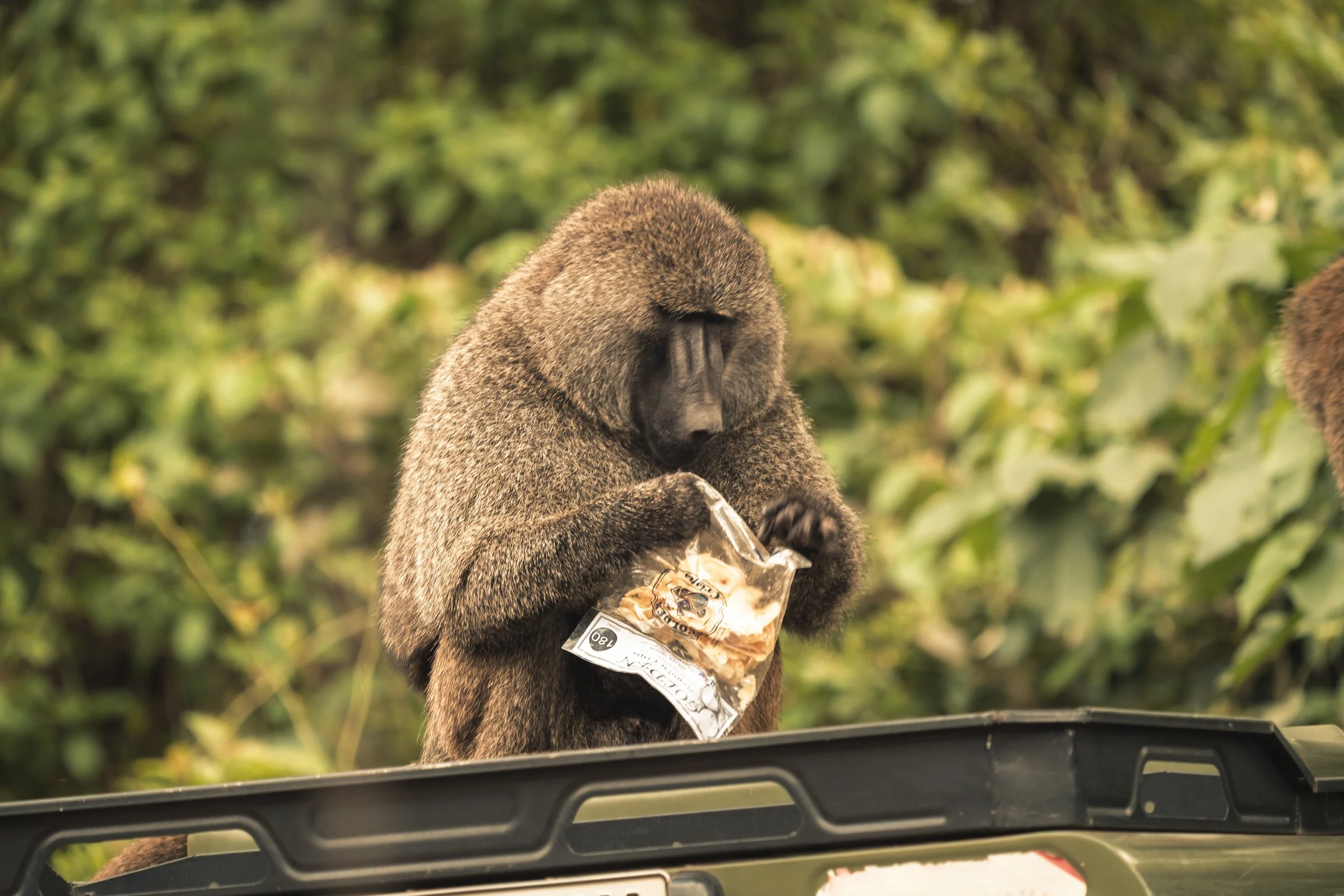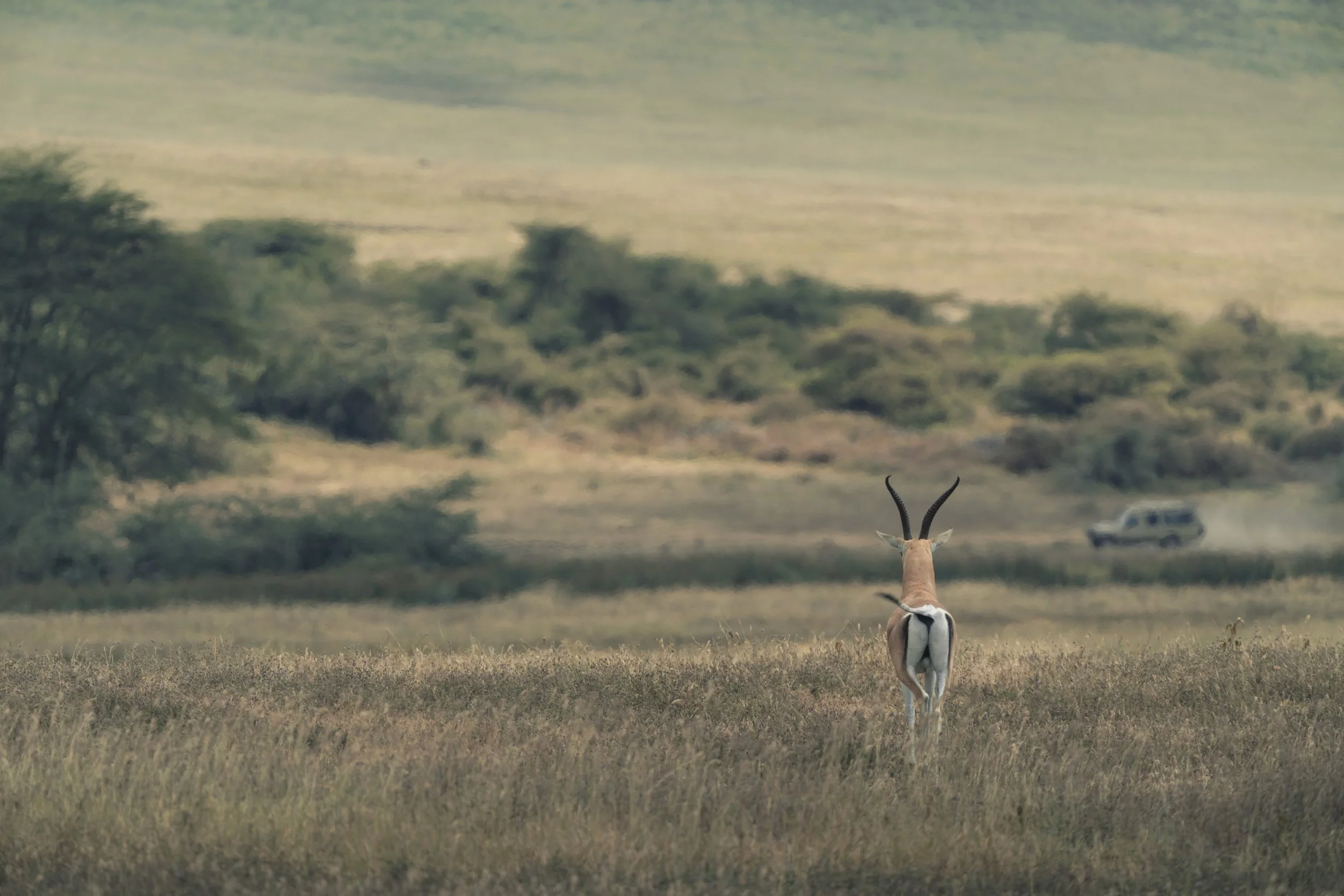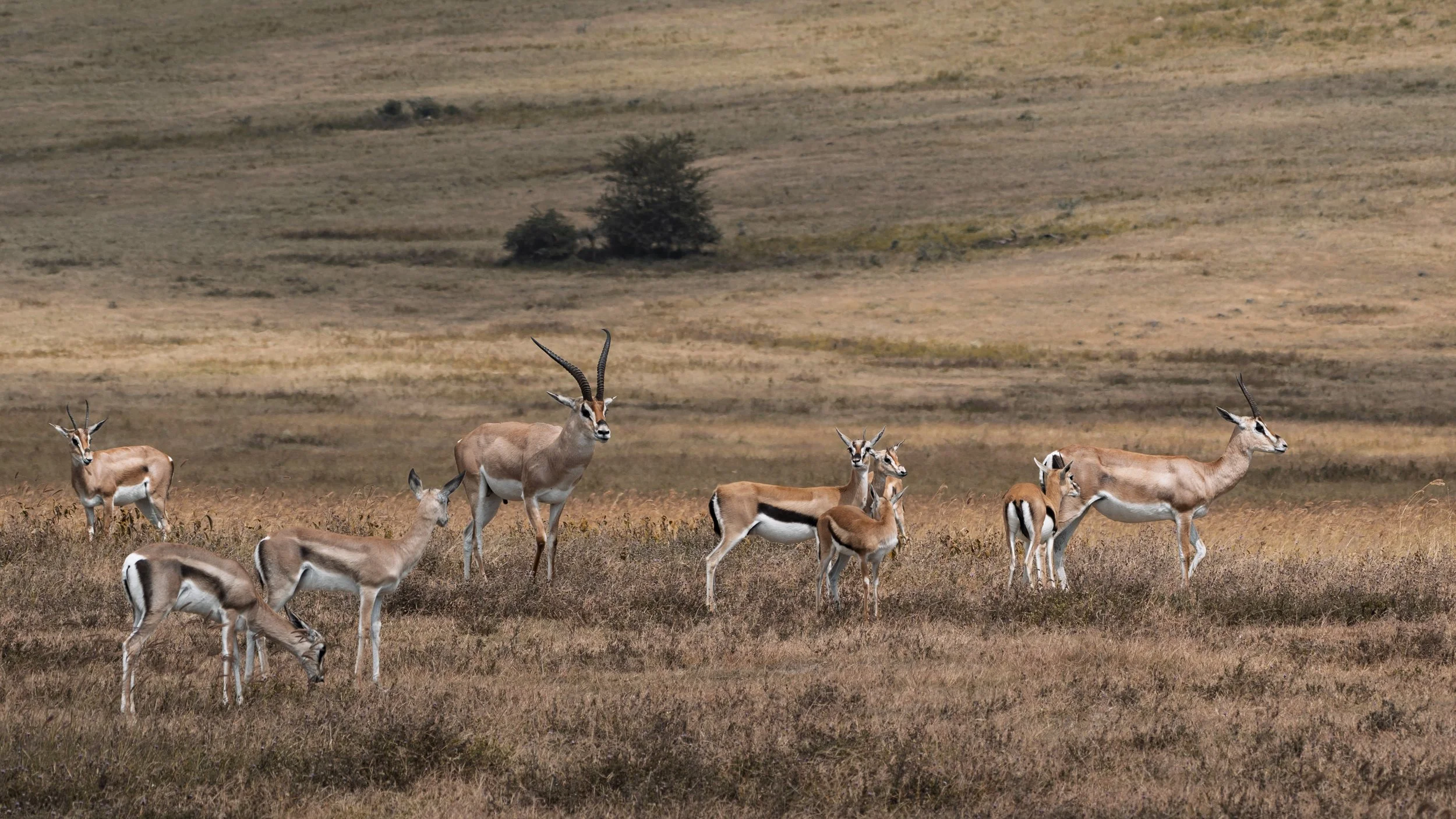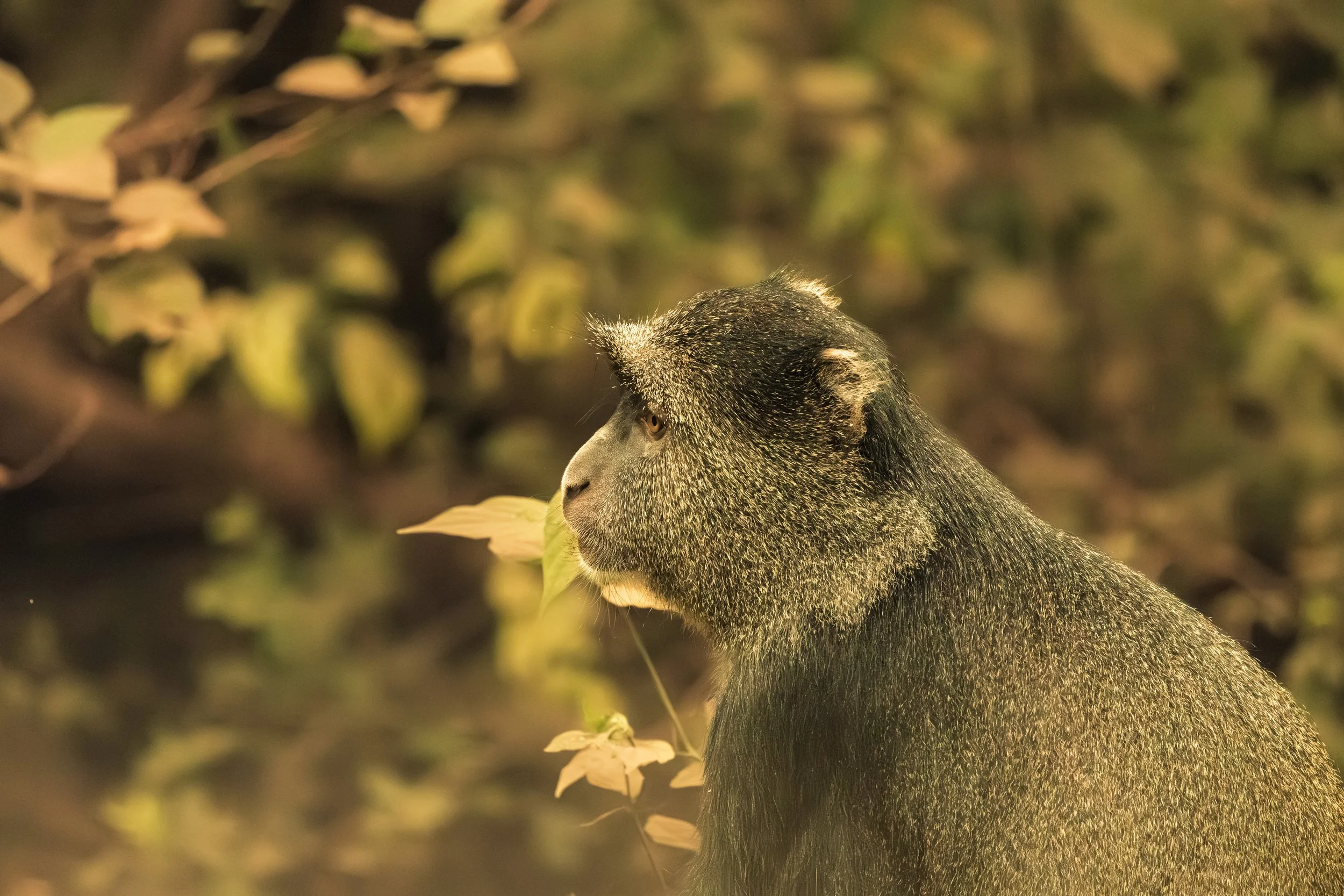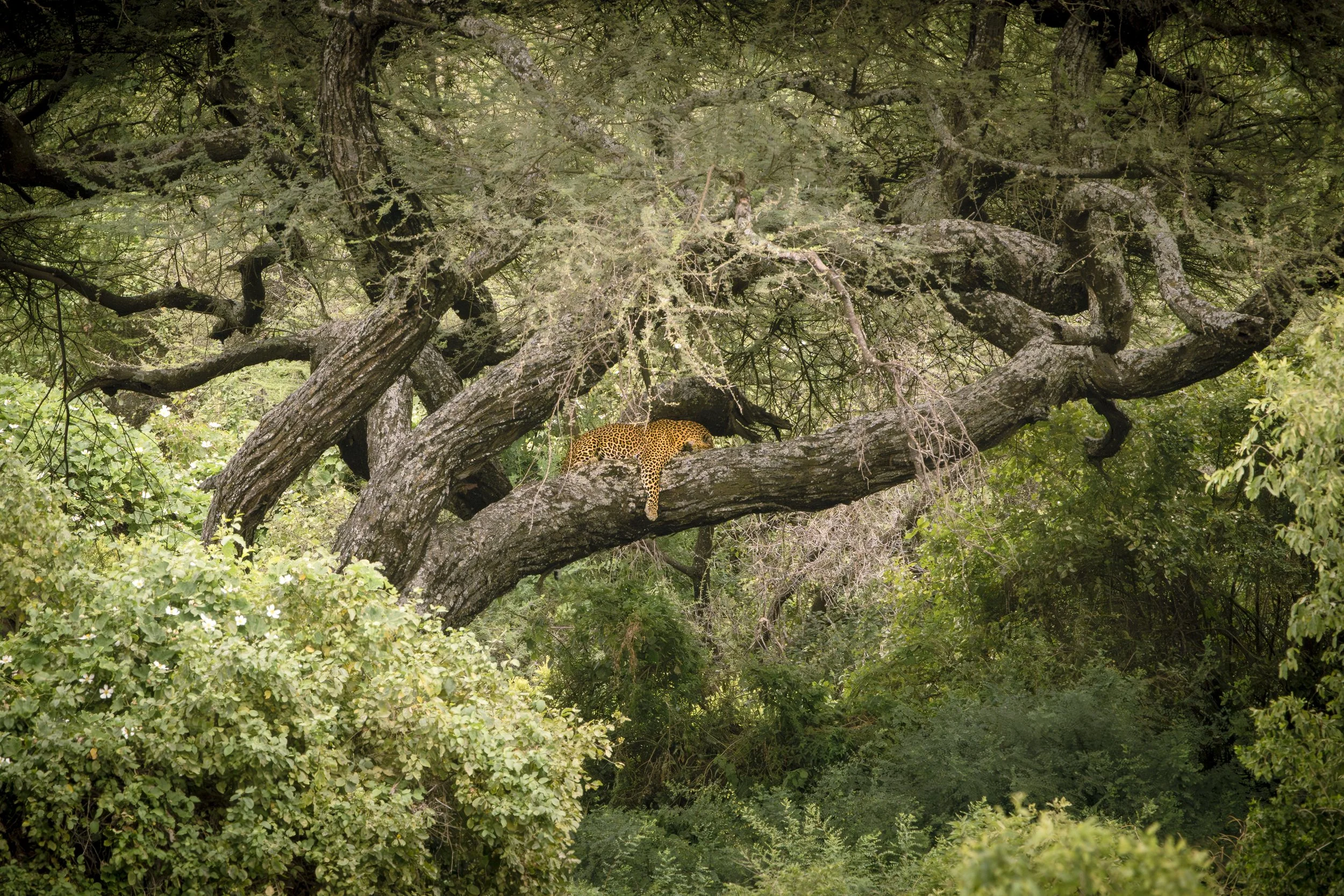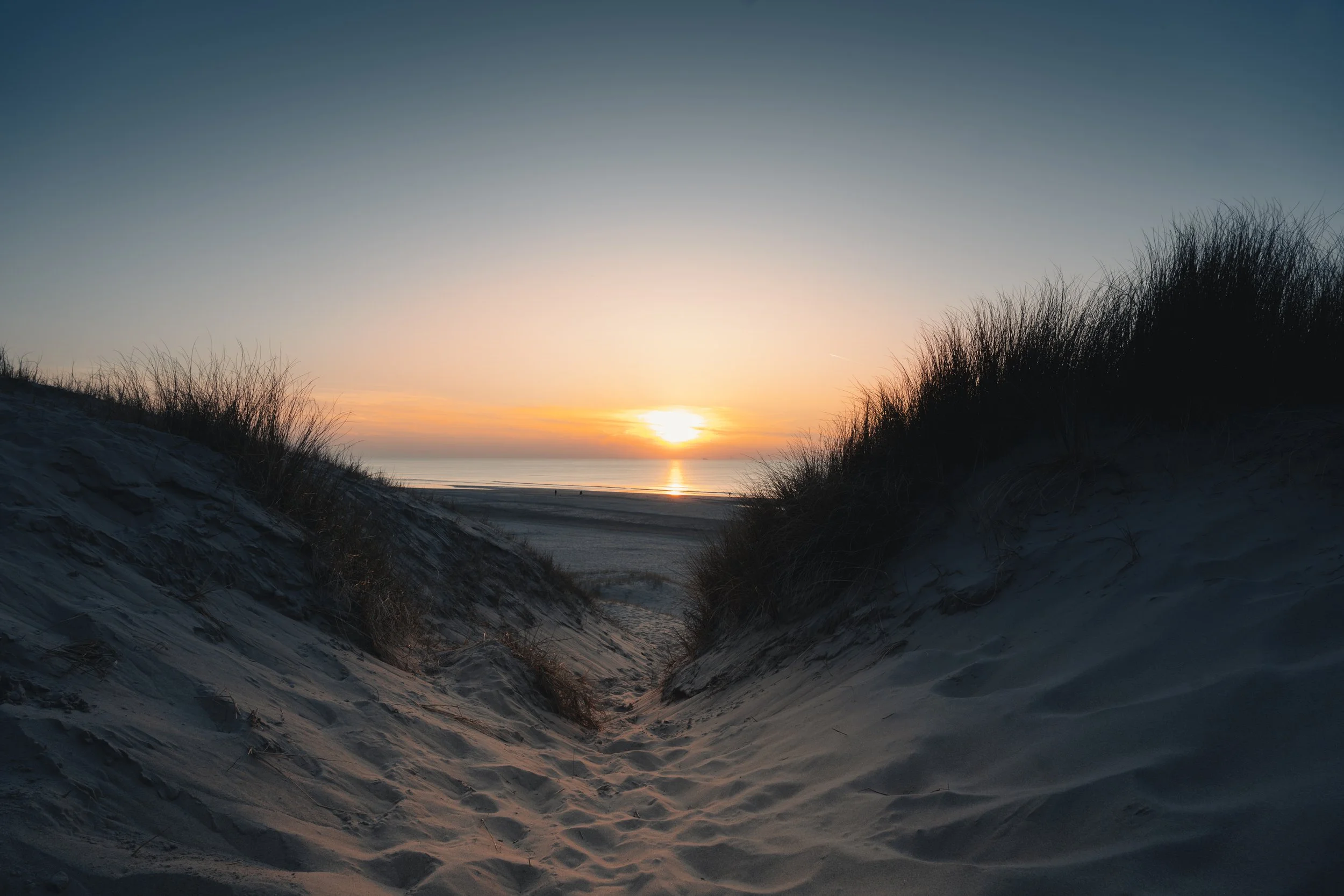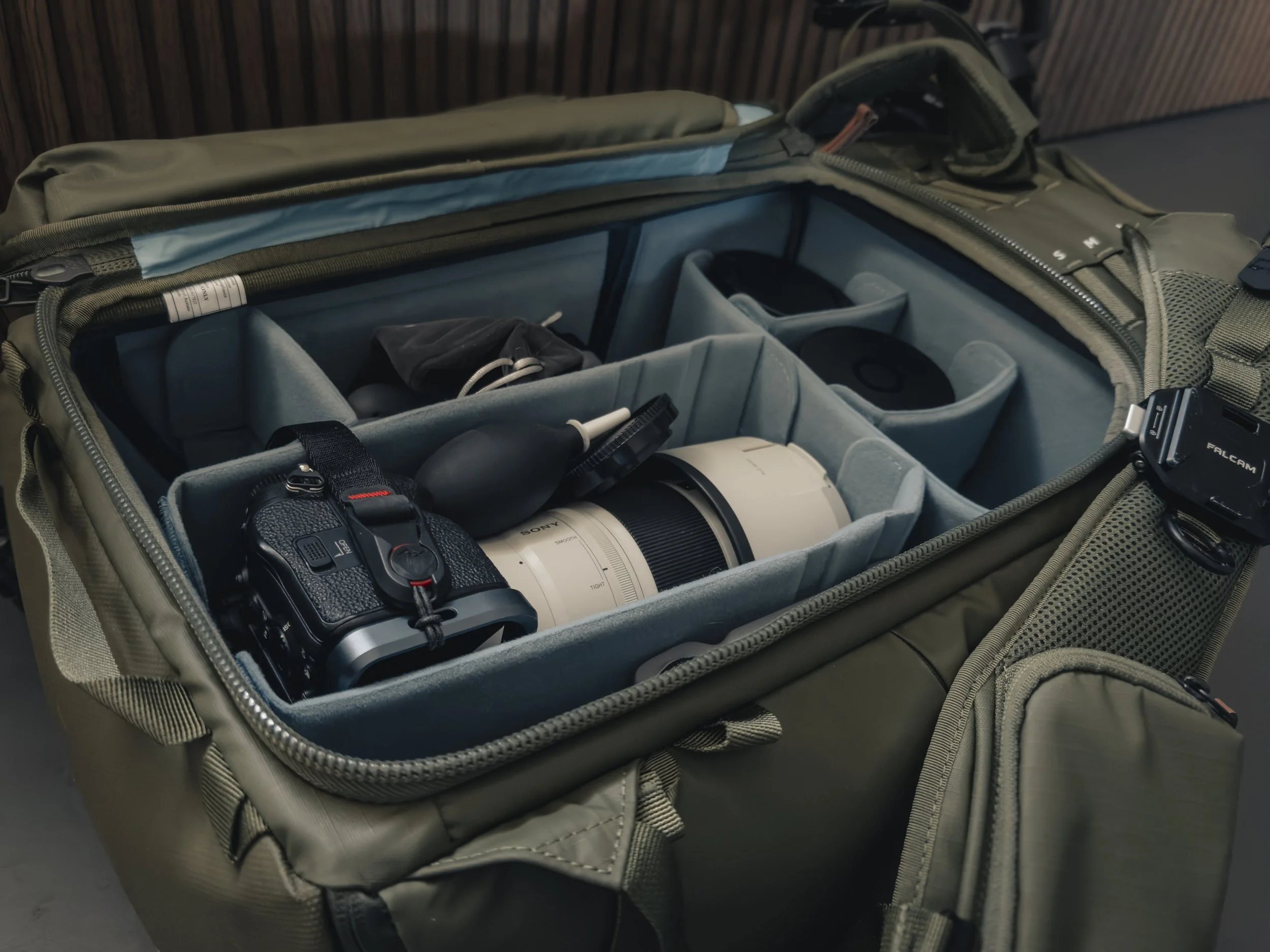Hapa na Sasa
Our trip through Tanzania still feels fresh, even though it's been three months. It took longer than anticipated to complete the film I wanted to dedicate to it.
"Our trip through Tanzania still feels fresh, even though it's been three months. It took longer than expected to complete the film I wanted to dedicate to it."
Briefly back...
Our previous trip to Switzerland remained undocumented. For months before, I had a complete video in my head. With the music chosen in my AirPods, I visualized every shot, every cut, every transition every morning on my way to the train. The "script" was completely in my head, only the locations needed to be filled in.
But reality turned out differently. Bad weather, drone bans, circumstances that didn't fit my plan. And I had a hard time accepting that. It cost me so much energy that I hardly had any fun. At one point I even stopped filming.
Later I realized that this was not about creativity, but about expectations - and the inability to let go when those expectations fall apart. Once I had that realization, I began to relax. I shot some images anyway, even though I knew the film I envisioned might not come to pass.
Once home, I tinkered with a rough edit anyway, with a message that was about letting go and accepting. Ironically, a mistake caused me to lose most of the original footage, so the video was never finished. Perhaps that was also the lesson; that it wasn't about the film, but what I learned from it.
Tanzania: a different experience
And then there was Tanzania. Again, my creative brain started spinning months in advance. During walks to the station, another plan emerged: a series of five episodes, prologue and epilogue, complete with music and concept. How that concept should have looked I won't dwell on for once, but the bottom line is that it was quite ambitious. And, looking back, totally unrealistic. If I could have stayed there for a few months, then maybe....
But this time things turned out differently. Despite my ideas and expectations, I allowed myself to move with reality. And because of that, the fun remained intact; we enjoyed every minute.
And even though I had to adjust my ambitions, a film came out of it that is dear to me. Because I was ready for what was coming in that moment. And I was aware of the privilege of being able to be here.
Memories that remain
The memories, the impressions, the people, they stay with you. How you hold your breath when, for the first time in your life, you see a herd of wild elephants walk by you just a few feet away and see so much more in them than just animals.
The inner excitement you have to contain to get that one shot of that leopard in a tree. The surreal feeling when you have the king of the animal kingdom in your camera frame for the first time and the lump in the throat when you float in a balloon dozens of meters above the Serengeti and for a moment everything seems to make sense.
The moral of the story; life is so much more rewarding in the here and now. And I need to keep reminding myself of that. Much more often than I do. That is what the wonderful animals we have seen also live in.
That's why, unlike us, they are truly wild and free.
And this is why photography and videography fascinate me so much. Because it brings me back to the moment and shows me what is real, between expectation and reality.
Mwisho wa safari
The end of the journey
"The end of the journey"
After some wonderful last sightings in the Serengeti, our drive back begins. We drive via Ngorongoro and Lake Manyara to Mto wa Mbu.
Along the way we stop at a Heritage Information Point, one of the open-access information points that combines paleoanthropological history with a concise overview of Tanzania's history, intended to make visitors aware of the unique significance of the area between Ngorongoro and the Serengeti.
Tanzania is proud of its role in human evolutionary history, national identity, independence and cultural richness. It emphasizes the country's role as "The Cradle of Mankind."
On display outside are sculpted skulls of Paranthropus boisei and Homo habilis, two extinct humanoids that play an important role in the story of human evolution. They were both found in the Olduvai Gorge area of Tanzania, one of the world's most iconic archaeological sites.
Paranthropus boisei is more widely known as "Nutcracker Man." He lived off plants, his skull built for strength. A side branch of the evolutionary tree, extinct, but significant. Homo habilis was smaller, slimmer, holding stone tools - and is considered an early ancestor of modern man.
But.
That modern man also had to use debit cards. Jabiri advanced some fees because debit cards were not available everywhere and there is a daily limit. So we try to withdraw money with two cards every day.
At a bank near our lodge I withdraw the maximum amount - and decide to just try again with the same card. Surprisingly, it works. Problem solved.
Since €100 equals 299,787 TZS, we temporarily feel like millionaires for a while.
Arrival at the lodge
We drive through a small village and come to a barrier where Jabiri pays some kind of local tax. A little later we arrive at our lodge, where we will spend the last two days. We decided to end the trip here in peace, rather than fly to Zanzibar or Mafia Island.
It immediately looks beautiful. A lighted path leads through the reception area and terrace to an infinity pool overlooking Lake Manyara. We are welcomed with a glass of bubbly and given a brief briefing.
In the evening we are only allowed to go to our lodge under escort. We bring our things to the room and agree to have dinner later.
Arrow and Bow
Our lodge, number 10, is the last one on the property. It is actually a small villa with spacious bedroom, coffee corner, large bathroom, outdoor shower, terrace AND its own plunge pool overlooking the lake.
After a short break we call for a pick-up. A security guard with a bow and arrow picks us up. That surprises us a bit. Against a hippo, such a weapon would not do much, we think.
Later we hear that it is meant for possible hippos from the lake. Although it later turns out that this situation has never occurred. Of course we understand the need for guidance, especially after stories about hippos at tent camps, but here it also seems partly for show.
The security guards all carry a uniform, two knives and a bow and arrow. Anyway, we survived.
Manyara Secret
Manyara Secret is known for its breathtaking views and focus on ecological and social responsibility. There are brochures in the villa about their sustainable approach, which is also evident in the furnishings.
In the evening, we enjoy a four-course dinner. Everything is fresh and full of flavor. We don't want to offend any Italians, but the spaghetti we ate here was perhaps one of the tastiest we've ever had.
We finish eating last and crawl into our bed satisfied. We decide to have breakfast a little later the next morning. Now that we are staying in luxury and only have to relax, we can sleep in.
Day full of relaxation
Still, we wake up early. We drink coffee on the terrace, write some more on the blog, select photos and read. The weather is perfect: blue sky, gentle breeze. My main task today: choose which massage I want. Difficult life.
After breakfast, I book the massage and we spend the day in and around the pool. In the water, book in hand, we enjoy the "nothing must, everything goes" feeling. Time fades away.
With Jabiri, I secretly arrange a cake for Jeroen. He's not celebrating his birthday, but I'm sure a piece of cake will do. I also invite Jabiri for lunch. Not much later, our table is set for three. After dessert, the entire staff appears singing and dancing, with full birthday cake and personal inscription.
We are the only guests during the day, so we decide to share the cake with all the staff present. It is a beautiful, warm experience.
Massage & campfire
After lunch I have to move quickly: my massage was supposed to be at 1:30 p.m., but by now it's already 2:15 p.m. Fortunately no problem according to the staff. The massage takes place on our own terrace at the villa and is great. Then we quietly work on the blog again, select photos, read and enjoy another fantastic dinner. We end the evening at the campfire with a drink.
Last day & departure
We have breakfast later than usual, get to check out a little later and have lunch at the lodge before departure. Then ... a push notification from Schiphol Airport: flight canceled. Panic! But fortunately it turns out to be the flight from the day before. Relief follows.
After a final shower, we install ourselves on the terrace until Jabiri picks us up. The drive to the airport takes about 3 to 4 hours. Since we don't fly until 9 p.m., we end up in the evening rush hour. Jabiri warns that it is a big airport. Oops - maybe we should have taken a little more leeway.
We say goodbye to Jabiri, thank him again for his care, enthusiasm and knowledge, pack our bags and walk into the airport. Big for Tanzania, but within 20 minutes we are at the gate. Not so bad.
Asante Sana
What a journey. Intense, but amazing. The kindness of the people, the delicious food, the impressive animals and the beautiful landscapes - Tanzania stole our hearts.
Thank you to Tamara and Osman of Gama Tours & Safari for putting together this trip perfectly that fit us seamlessly.
Special thanks to Jabiri for his fantastic guidance, knowledge and genuine kindness.
Thanks also to everyone who followed our journey through this blog or our instagram accounts.
We hope that in this way we have fulfilled the wish that Jabiri expressed at the very beginning of the vacation. And that is that we would tell home how beautiful Tanzania is and that it is safe to travel there. We can both agree.
And now?
This "new" blog will be quiet for a while. After all, money has to be earned first in order to start the next adventure. Where that will be, we don't know yet. We certainly have ideas and plans. But as with so much in life, everything still has to fall into place. Pole pole, and Hakuna Matata.
Jeroen has more than enough photos to keep posting on his instagram account and his website in the coming period, and a video of the whole trip will also be released on his Youtube channel (and here) as usual by now. That will take some more time....
For now, we say thanks for reading and until the next adventure, far or closer to home.
Jeroen & Evita
Serengeti Finale
The balloon flight was literally and figuratively a highlight - but the Serengeti, it turned out, was not done yet.
"The balloon flight was literally and figuratively a highlight - but the Serengeti proved to be unfinished business."
The balloon flight over the Serengeti had given me new energy. At least, new - I felt clear and fully capable of enjoying this wonderful experience. But I hadn't slept that already short night, so sometime during the day I was bound to run into that hammer.
Hopefully that moment would be a while off, as we had plenty of time after the flight to further explore the Serengeti - this time by land again. Then we would begin the return journey toward Lake Manyara, where we would immerse ourselves in some more luxury for a moment of relaxation. Not that we had lacked any comfort at all over the past few days, by the way.
So after reuniting with Jabiri and updating him on the progress of the balloon flight, we set off again.
A full stage
And once again the Serengeti would not disappoint us. Arriving at a large rock formation, we saw two lions lying on top. Behind them was at least one cub, but we only got a very brief and only partial view of it. Here again we saw clear similarities to our own mini-lions at home: preferring to seek a higher spot and laze about.
Not much later, we came across a herd of elephants - and not just any herd, but a particularly large group with several calves. We saw elephants frolicking, correcting and grooming each other. There was even an impetus to produce new calves, but another male resolutely put a stop to that.
The mood was good: there were quite a few more males walking around in a, shall we say, excited state.
Surrounded by giants
The herd was spread into several smaller groups around us. Slowly, those groups began to merge - and we stood with our car right in the middle. Thus, the elephants got closer and closer.
One of the "small" elephants was a little more interested in our car than the rest. With his trunk, he began to cautiously explore the car. Meanwhile, the older elephants also approached and gathered around the car. For a moment I thought they would push us over, but instead they walked slowly and steadily around us.
Jabiri advised me to stay as still as possible. At one point, the elephants were less than a meter from me - with only the car window acting as a barrier between us and these impressive animals.
It was an incredible moment to be so close to these quiet giants.
The herd gathered at a pool of water diagonally behind our car. Yet they seemed in no hurry to take a bath. We decided to continue our way, looking for a place to have lunch.
Hunting before lunch
But even before we could settle down anywhere, we crossed the path of a lioness. She was panting heavily and looking straight ahead, as if concentrating on something.
After a while, her attitude suddenly changed. She heard something, smelled something - or maybe both. Her head turned and she began to move purposefully, heading straight for our car.
It soon became clear that we were not her target. Behind us, in the direction her gaze was now moving, we saw it too: a group of antelope. It seemed we were not the only ones who were ready for lunch.
She began to move toward the antelopes at a faster pace. Until she apparently lost track of the scent and stayed in one spot. We waited some more, but there was no hunt. Not yet, anyway.
We had to move on, unfortunately, because even in Serengeti, there is a maximum time you can stay in the park. And that is all recorded. Apart from that, we also had a long drive back towards Lake Manyara to go. We looked for a nice tree to park the car under and eat our lunch.
But there remain opportunities you can't pass up. A group of jeeps had gathered in a semi-circle, usually a sign that there is something to see. And whether there was something to see ... it was a cheetah devouring (just) caught prey. She sat with her head among the tall grass to take in her lunch. Complete with the sound of crunching bones.
Occasionally she would come up to check for any danger or scavengers lurking about. That we were there didn't seem to interest her at all.
Where a hunting animal like the cheetah is feeding, scavengers are often not far away. Not even now, a jackal wandered a safe distance from the cheetah and her prey, obviously waiting for a chance to sneak a bite to eat.
We really had to start driving toward the exit now. At the end of the afternoon we again passed the gate of the Serengeti. Then you know it's time for paperwork...fortunately it never takes long and it's also a great opportunity to stretch your legs.
By now it had gotten a little cloudier and when we were out of the park a little later it even started to blow pretty hard. With the unpaved roads, this caused quite a lot of extra sand to blow up. A little later, however, it started to rain a little which limited its effect.
En route to Lake Manyara for some more relaxation to finish!
Ballooni ya Hera
Biggest of smiles, fullest of hearts.
"Biggest of smiles, fullest of hearts."
When we returned to the lodge after the first intensive but great day in Serengeti National Park, Jabiri told Jeroen that he wanted to show him something and that I could walk to the restaurant. Strange I think.
I arrive at the restaurant and instead of sitting at our own table - yes we have a set table - I am asked to sit at a table on the other side of the tent. I want to sit down, but the chef insists on pushing my chair and gives me another seat.
The chef explains the menu to me, promises to give me really small portions this time, and chats some more. Then someone else from the staff comes to ask how my day was. When I ask about Jeroen, they tell me he is still with Jabiri. Oh well, whatever... Every now and then I turn a bit in my chair because I can't see much outside from where I am sitting. Then another employee sits down in front of me. He too asks about the day and chats away a hundred.
Not much later, Jeroen steps in. We decide to quickly charge some devices in the tent and then have dinner. Jabiri can finally eat with us tonight because the car has been fixed. So in the tent I ask Jeroen what Jabiri wanted to show him. "Oh, something about the car" was the reply. I find it rather strange and think my husband is rather short-tempered.
We really needed to eat now, so I let it go....
Music and dance
Together with Jabiri we enjoy a delicious dinner. I find it incredibly pleasant that he can join us for dinner tonight and that we now have different conversations. He talks passionately about his work as a guide, his family and their plans for the future.
After dinner, the daily briefing begins: what time will we have breakfast, leave, what will we do, etc. Jabiri asks if I'm okay with us reporting as early as five o'clock. Fine with me. Jeroen thinks it's fine too.
And then suddenly Jabiri says "someone else will pick you up and I'll see you at 10 o'clock."
Then my brain starts working overtime....
Huh, what are we going to do then? Why isn't Jabiri going with us? Why so early, the sun doesn't rise until quarter to 7? I don't have much time to think. The staff starts singing and they dance all over the tent. It's great to see their cheerfulness and enthusiasm. Eventually we dance and sing along.
Just back in time
In March, we booked our trip. After weighing some options, we were very happy with the trip we had planned. As an option we had listed a balloon flight. It was a bit pricey, so we left it as an option for now. We could reconsider it later.
When my sister Iris and her little son Seve came to stay for a night in May, I said to Jeroen: surely I'm going to ask if they can check availability and book the balloon ride. The owner was going to find out for me, but informed us a day later that unfortunately everything was fully booked. She would let me know if a spot became available.
Back to now
While the staff is singing and dancing, Jabiri walks out to grab his phone. And suddenly I think I know what all the secrecy was about and why we are going to leave so early.
Or is it? I look at Jeroen and ask him if we are going to do a balloon ride? Jeroen laughs and half denies it, but I have known him too long. We dance and sing some more, but my evening was already perfect. What a surprise and so well organized, I didn't suspect anything.
After dinner, we pack up everything and set the alarm. 4:30! I'm loving it.
Early birds and flames in the distance
I wake up just before the alarm clock. I am ready for it. Jeroen unfortunately has not been able to sleep, so for him it is a spirited morning. We take only a bag of cameras and are escorted from our tent to the jeep that has just arrived.
We board with guide Paul and driver Abdullah. In front of us are Roxanne and Theo, a newly married couple from France. Their pickup time was 4:00. Then 5:10 is not so bad. We drive for about 40 minutes and arrive at the launch site. From afar, we can already see the flames going on and off.
The reception looks idyllic: there are lanterns hanging in the trees and lights along the paths. There is coffee and tea, there are heaters and fortunately extensive sanitary facilities have also been thought of. We decide to forgo the coffee and tea and enjoy the slowly turning pink in the sky.
After half an hour of waiting, we are given a short welcome by Cesar, the chief pilot. Paul tells us that we will walk to balloon 4. There it turns out that Cesar will be our pilot. 16 people fit in our balloon and on this flight we share the compartment on the lower left with Roxanne and Theo, two Americans, two Belgians, some French and four Chinese.
The security briefing starts and it soon becomes apparent that three of the three Chinese do not understand a word of English. One of them, remarkably enough, will act as interpreter, but of course this does not go very smoothly. Cesar asks us all at the beginning of the briefing if we don't want to film so that we can devote our full attention to his explanation of procedures and safety regulations. The interpreter then decides to film following that request. That's going to be something...
Cesar interrupts his explanation several times to ask the interpreter if she will translate, but little comes of it.
Adventure, upside down...
The basket we have to get into is still tilted on the floor when we are allowed to crawl into it. Fortunately, we have a compartment near the ground, which is easier. We take our seats and follow the instructions. So we lie upside down in the basket on the floor for a few minutes. I him a smile from ear to ear. What an experience, already!
Cesar starts letting fire into the balloon and before we know it he has the basket upright. Then almost immediately I hear him call out in frustration. One of the Chinese has already untied himself and stood up. Just minutes before, he had explained that we were to stand only when he gives the signal to do so. They understood nothing of the briefing.
We see that all the balloons next to us are also ready to take off and within still time we are taking off. As soon as we are off the ground Cesar lets us know that we can stand. The view is beautiful from the very first second. It couldn't be any different in the Serengeti. The weather couldn't be better this morning, the sky is crystal clear.
The sun slowly continues to rise, the skies turn pink and orange and the landscape takes on a beautiful warm glow. The clear blue sky provides the perfect backdrop for the other hot air balloons in the sky. How lucky that just today the morning begins without thick clouds. On the ground we see a cheetah, elephants, giraffes, zebras, topis, a hyena, buffalo, impala, gazelle and a dik-dik.
I am speechless from it. Of all the beauty, the whole experience and Jeroen's sweet surprise.
In one word: GREAT.
Hard ground, soft landing
After being in the air for an hour, we land. Beforehand, Cesar told us that there are three ways to land, but that we can forget about landing one and two. He also calls landing one and two "the boring landing. In landing one, you just land vertically on the ground in one go. That's it.
On landing two, you first hop several times, but the tray also stays upright. Cesar explains that it is often windy on the Serengeti, so landing one and two almost never happen. Now I have to be honest: most of the one-liners and jokes made have been seen before in youtube videos, so it may also be part of the experience to indicate that they expect an exciting landing.
We are prepared by Cesar for landing number three. A landing in which we hit the ground several times, tip over and are pulled along on the ground for another bit. The moment to land has come, so we are going to see it. Cesar soon announces that it will be a "boring landing" after all. Fine by me. The landing does indeed go smoothly. The men to help us are ready and in no time we are helped out of the basket.
French tradition
We are treated to a glass of champagne, which is a worldwide tradition after a balloon flight. That tradition originated in France, where the Montgolfier brothers conducted the first manned balloon flights in the 18th century. They often landed in agricultural areas. Farmers were initially frightened by these "flying monsters" that fell from the sky, were afraid they might affect the weather and often reacted with hostility.
To reassure them and to show good will, balloonists began pouring a bottle of champagne or wine after landing and sharing it with people on the spot.
Thus grew the tradition of drinking champagne after a safe landing in celebration of a successful flight, a symbol of gratitude and a moment of connection.
We toast with the crew and other passengers and some more photos are taken
Breakfast and loo with a view
Then we got back into the jeep and headed to the picnic area for a full breakfast. We chat some more with the French couple we shared the jeep and flight with. It is their honeymoon so they are invited for a piece of cake to celebrate that moment. There is singing and dancing.
I go to the loo with a beautiful view of the plains. A loo with a view. Now I have viewed the Serengeti in every way possible.
It is now 10 o'clock. Time to move on to the final game drive on the Serengeti. Jabiri comes to pick us up at the park visitor center
I can't say other than that it was an unforgettable surprise and experience.
Serengeti
What began as a quiet morning at camp grew into a day full of surprises. Sometimes delays get you exactly where you need to be.
"What started as a quiet morning in camp grew into a day full of surprises. Sometimes delays get you exactly where you need to be."
Early awake, deeply rested
Not surprisingly, on the first day in the Serengeti, as usual, I wake up early. Yet throughout the vacation I actually sleep pretty well for my standards. I do wake up early, but I fall asleep quickly and I also feel like I slept deeply. And to think that hippos and other animals can be heard throughout the night. At least I heard them when I went to bed and also when I woke up again.
Guidance through the darkness
Since it is still dark when we want to have breakfast, we must be escorted by one of the camp staff. This is done by asking using the walkie-talkie available in the room. Within minutes someone will then be in front of your tent. And regardless of the time of day always with a smile and an enthusiastic "Jambo Jambo!"
You also agree in advance when you want to shower. Then someone will be outside the tent at the agreed time to turn on the water supply. It is then a bit of a wait for the hot water, because it has to come on first. I didn't wait for it. It's a waste of water that washes away first and a cold shower is quite refreshing.
Alles lekker?
The food at Serengeti Tortilis Camp is excellent, and the staff is genuinely friendly and helpful. Everywhere we go, we notice how much people like it when you speak a few words of Swahili. They are happy to teach you new expressions and are curious about where you are from, and what language we speak.
Image credit: Serengeti Tortilis Camp
We taught one of the boys "good morning," "hoi" and "doei" Moments later he came back and said with a big grin, "Hoi, alles lekker?" Evita and I both shot into laughter. It was SO funny and unexpected. He had obviously googled Dutch phrases for a while.
Unlike many other nationalities, here they apparently have no trouble with our gurgling "g" and rolling "r." After two tries, his "goedemorgen" sounded perfect.
So we just explained to him the Dutch form of "Pole Pole" (at least our interpretation of it). A few attempts later, he proudly exclaimed "rustaaaggg!".
Car trouble and vultures
We asked briefly if Jabiri had returned yet. We hadn't heard from him and were a little worried. One of the guys immediately went to find out for us. A little later he came back with the report: it had not been possible to fix the car, but Jabiri was on his way.
Not much later, he arrived. His messages appeared to be delayed - I did not receive them until he was already at the table. Since the ignition was still not working, it was idling at the entrance to the camp.
After breakfast, we drove to a "garage" further into the park. Of course: along the way we kept enjoying what we came across. And what we encountered was special, a cheetah with a cub. The latter was difficult to get a picture of due to his or her size and the tall grass, but fortunately we were able to witness it with our own eyes and hear it calling to her mother.
When we arrived at the workshop, my eye immediately fell on an old Jeep with a recognizable logo, that of Leiden University, my hometown. Further along is a camp where researchers are staying. But maybe the car was left here a long time ago - in fact, a battery was lifted out moments later.
Jabiri's friend tried to get the ignition working. Meanwhile, another Land Cruiser was driven onto a makeshift bridge. The passenger turned out to be Dutch. They had gotten stuck in a ditch earlier - gearbox broken. Fortunately for them, that was quickly fixed.
In our case, too, it turned out to be not too bad in the end. After a few tries, the ignition caught on, and it kept working. Unbelievable really, that something like that is just "fixed" in the middle of the wilderness. While we waited, I took some pictures of vultures circling above us. Possibly there was prey nearby.
We were able to get back on the road. Jabiri was relieved - "This problem almost took my smile away," he said. But this is Africa. Hakuna Matata.
Lioness in tree
I'm not at all superstitious, so I don't believe in "fate" or "everything happens for a reason," but who knows, maybe this delay actually led us to something special. Something we would have missed had we been there earlier. And that seemed to be true.
Because not much later we saw a beautiful lioness lying in a tree. Half in the sun, half in the shade. Jeep after jeep had gathered at a distance to admire her, but she was not distracted by anything. An occasional glance, an ear moving, but otherwise - total quiet.
Lions don't often rest in trees. But if the trunk is not too high or too difficult, they are still willing to try. Lionesses more often than males. For males, it's less comfortable. Their noble parts just get in the way.
It was the most beautiful lion sight yet. She clearly had absolutely no intention of exerting herself one way or the other; she was clearly enjoying her peace and quiet, despite all the attention from people. We therefore continued on our way.
Cute stench
That road did not last long, because practically around the corner we saw several crocodiles at a pond. And a little further still a whole puddle full of hippos. They were floating in the water. Well, water ... shit with some water through it.
I had heard about it beforehand, but my goodness what a smell! To mark their territory, hippos are busy spreading their droppings, and that certainly doesn't leave the nostrils untouched! Still, there is something cute about them as they turn themselves onto their backs with those bulky bodies.
Big balls
Our luck persisted. Moments later we encountered another lion, it was a male this time. Also in a tree! Since it was not very far from where we saw the lioness, it was likely that they belonged to the same group.
The male was clearly less comfortable lying down. He moved around a lot, lay down in different ways and seemed somewhat restless. According to Jabiri, it was obvious why; his "big balls" were in the way. A few times he seemed to want to get off, but apparently his laziness still won out over the discomfort.
Migration in the front row
That afternoon at a rest stop, Jabiri ran into his landlord - who, in addition to being a landlord, is also a guide. He told of a spot where the last large group of wildebeest and zebra were heading, on their route of the great migration. In the distance we could already see the mass gathering.
After a brief sanitary stop, we drove in that direction. We came to a place where the animals had to cross the road. And we were in the front row.
What we saw here is hard to convey well. Thousands of animals running in one straight line behind each other. And at the point where the jeeps are driving they speed up to cross the road. Visibility here, due to the landscape and clear weather, is limited only by your own eyes. And whether you look left or right, the beginning and end of the parade is literally impossible to see.
We stood still at this point for perhaps half an hour and there was simply literally no end to it.... Particularly impressive.
Travel companions for life
Zebras and wildebeests have a special partnership during migration. Every year, more than 1.5 million wildebeest and some 200,000 zebras migrate from the Serengeti to the Masai Mara in Kenya. In search of rain, of grass, of survival.
The zebras eat the long, tough grass that has to go first. Only after that comes the tender, young grass that the wildebeest love. As if the zebras are preparing the field for their traveling companions.
They also complement each other in terms of survival. Zebras have sharp eyes and a good memory for danger. Wildebeest rely more on their sense of smell and their numbers. Together, they form a living shield against predators. Evolution has made them ideal travel partners.
A perfect day
It was clear by now that the end of the parade was nowhere near. But for us, the moment was complete. We returned to camp for a hot dinner and a quiet evening. And now that Jabiri was also fully back, he could join us for dinner.
I was already looking forward to tomorrow.
Because that day would hold another big surprise....
Arrival in Serengeti
We drive towards the open plains of the Serengeti. A long drive where emptiness feels vast, and the horizon never comes close.
“ We drive towards the open plains of the Serengeti. A long drive where emptiness feels vast, and the horizon never comes close. ”
From crater to plain
After our visit to the Ngorongoro Crater which is not a crater, we headed to the Serengeti. It was a long drive, and on the way we saw the landscape slowly transform.
Where the Ngorongoro still offered a variety of ecosystems, the landscape outside the crater became increasingly dry and flat. Low grasses dominated the view, interspersed with solitary trees and small groups of acacias.
Ironically, for a resident of one of the flattest countries in the world, it was still impressive. The emptiness here had a different scale. The horizon seems endless and because there are so few landmarks, the clouds seem to float higher. You get an almost surreal sense of space.
Not surprising, because the name “Serengeti” comes from the Maasai word “Siringet”, which means: “the place where the land goes on forever” or “endless plains.”
When European explorers first arrived in the area, they had difficulty pronouncing “Siringet” correctly. The “r” and “ng” sounds in particular proved difficult, and over time the word changed in their pronunciation. This linguistic adaptation eventually led to “Serengeti,” a version that was easier for non-Maasai speakers to pronounce and write.
When the area later gained international fame for its wildlife and natural beauty, the anglicized version stuck — eventually becoming the official name of both the ecosystem and the national park.
The gateway to another rhythm
After a few hours of driving we arrived at the first gate of the Serengeti National Park. There it stood, firm and resolute:
“Serengeti will never die.”
It is a statement made world famous in the 1960s by the Tanzanian conservative Bernhard Grzimek, who fought together with his son Michael to preserve this unique wilderness.
At the gate we were greeted by a group of young Maasai women. They wore colorful jewelry and offered bracelets for a dollar. As I gathered my camera gear, a few were already slid onto my wrist. I found it hard to say no — not because of the money, but because we already had a fair amount of souvenirs and we had seen this scene before. If we said yes every time, we would soon have half a market worth of stuff to drag home.
When it became clear that we would not buy anything, they asked for water. We checked with Jabiri who said it was ok. We had more than enough bottles in the cool box. He did however tell them to return the empty bottles so that they would not end up as waste in nature.
First animals, first worries
We drove on, towards the actual entrance of the park. While Jabiri bent over the necessary paperwork again, we used the toilet and stretched our legs.
Once through the entrance it wasn't long before we saw more animals. Including the now familiar Secretary Bird - with its long legs and elegant crest it remains a fascinating sight.
Not much later, on our way to camp, we came across two lions resting comfortably on top of a rock. Sure, they are predators. But at a time like this, they look more like oversized house cats — lethargic, content, almost cute.
Engine problems in the wild
There was still one problem. In the Ngorongoro crater, which is not a crater, the Land Cruiser would not start. The previous problem in Tarangire had been solved, but now it seemed to be an electronic defect — the gauges on the dashboard were also not working. Jabiri fortunately got the engine going again, with the help of another guide who gave us a push. The problem now is that the car had to be turned on all the time.
Luckily, in the Serengeti, Jabiri knew of a place where a mechanic friend might be able to help. He said he would drive there as soon as he dropped us off at camp. But it was getting dark fast — and because the electronics had failed, the headlights didn’t work either.
Despite that, we got a tip: a cheetah had been spotted nearby. We went looking, but the darkness won out over our enthusiasm. The animal remained untraceable and it was now really time to head for camp. We were still enjoying the magic of the moment, but were worried: Jabiri still had a long way to go without lights, in the middle of the Serengeti.
At our camp
Upon arrival at Serengeti Tortilis Camp we were warmly welcomed. The entire staff sang to us, with the now familiar sounds of the 'Jambo Song'. After a short briefing we were escorted to our tent - although 'tent' is perhaps an understatement.
It felt like a lodge under canvas: a generous bed, a cozy front room to sit outside but still protected from mosquitoes, a separate bathroom with a hot shower, and even an extra space in between with a bed.
In the evening we are escorted to and from our tent. Understandably, because this camp has no fence. The animals live freely here — and that is exactly the intention. As the sun set, we heard the recognizable snorting of hippos on the other side of the hill. We would continue to hear them for the next few nights.
In the main building we enjoyed a delicious dinner, prepared by a cheerful chef and served by very friendly guys.
Where is Jabiri?
We hoped that Jabiri would be back in time to have dinner with us, but as the evening progressed we began to wonder more and more: did he arrive safely at the mechanic's?
We took those worries back to our tent. I wanted to sort out some photos, make backups, and write some more for this blog — but let's be honest: after such long days, that's sometimes just too much. Not least because the internet here has… let's say, its own rhythm.
The photos and videos of Ngorongoro were also waiting for me, but at some point I gave up. Time to dive into bed. Tomorrow we would leave extra early: the plan was to leave before sunrise.
Whether that would work was questionable, given the problems with the car…
Ngorongoro
Ngorongoro feels like a world of its own. A deep green bowl full of life. The day starts with ginger to ward off the cold and ends with a rare moment.
“ Ngorongoro feels like a world of its own. A deep green bowl full of life. The day starts with ginger to fight the cold and ends with a rare moment. ”
Exciting start
After a wonderful night's sleep, I unfortunately don't wake up feeling completely fit. A cold, I think. At breakfast, Jabiri hands me a large mug of fresh, spicy ginger tea. In addition, I am given a piece of raw ginger with the advice: "Bite off pieces and chew slowly. Then you will be better tomorrow." I hope so.
Ginger is known here as a home remedy for everything from sore throats to nausea, so it is not uncommon in Tanzania to use it as a medicine instead of pills.
Cowbell
We leave for the Ngorongoro crater to spend the morning there. Yesterday I asked Jeroen how the crater was formed, to which he corrected me: Ngorongoro is not a real crater, but a caldera – the collapsed roof of a volcano, formed after an eruption, about two to three million years ago. Jabiri adds that “Ngorongoro” means 'cowbell' in Maasai, after the sound the bells of their cattle make.
When we arrive at the entrance, we are immediately struck by baboons everywhere. They walk on the ground, sit on roofs and in the bushes, and hang around the cars as if it were their territory – which it actually is. Jabiri urges us to close the windows and keep a close eye on the doors. These monkeys are so used to tourists that they know exactly when to seize their chance.
We meet Abu, the guide who was on the road with my cousin Loes last week. Thanks to her and my aunt Veronique we ended up at Gama Tours. We saw on Instagram that they had a great experience. My aunt is returning in January 2026 to see the migration - something to be jealous of.
Not much later we experience with our own eyes why the windows have to stay closed. A group of tourists from America is not alert for a moment and in no time a baboon is in their jeep. With a bag of chips he jumps out triumphantly and installs himself on the car roof, where he devours everything on the spot. Sharing? No way. But because the packaging ends up on the ground, his fellow species still benefit.
The descent into the bubble
The drive continues upwards. Mist surrounds us, visibility is minimal. Jabiri assures us that it will be clear in the crater itself. At the second entrance gate, the mist slowly lifts, and we begin the descent. Jabiri puts the car in low gear because of the steep road. From above, the plain seems quiet and empty, but that image changes once we have descended.
The Ngorongoro Caldera feels like a closed world — an ecosystem in itself with its own microclimate. It is home to some 25,000 large mammals. It is one of the only places on earth where you can spot the entire 'Big Five' in a day. Although the chance of seeing the black rhino is small.
First encounters
Upon entering we immediately see elephants, buffalos, gazelles and the 'common chad' — a common bird that lives in the lakes, especially in Lake Magadi that lies in the middle of the crater. Not much later we spot a lioness, lazily in the grass. Between the trees at the edge of the mountains lie two more lions, but too far away for a good photo. Still, it is an impressive moment.
Special behavior
A little later we come across another elephant that apparently had more of an appetite for what was hanging in a tree. After a few failed attempts, the elephant stands on its hind legs and gets what it wants. We had seen this behavior before in videos about Mana Pools National Park in Zimbabwe, where elephants display this behavior, especially when food is scarce. The elephants there have learned this behavior themselves over several generations. We had no idea that this behavior had also developed in other places. Unfortunately, we were photo-bombed and the exact moment was unfortunately not captured.
What a smell
Then we see a hippo, with a little one. You usually smell them before you see them, and that is not necessarily a pleasant experience. Jabiri smiles and tells us that we will see many more in the Serengeti, especially in the swamps. But for me this one is enough.
We continue and see wildebeest and for the first time ostriches — impressive animals, especially the male with his black feathers and pink legs. They can run up to 70 km/h, an impressive feat for such a large animal.
Rhinoceros. Or not?
I make extensive use of the binoculars today. In the Ngorongoro crater, most animals are at a greater distance during our safari. Jabiri also has a pair of binoculars and after an hour in the crater, Jabiri points out a black rhino. Unfortunately, it is so far away that I cannot clearly see whether it is a black rhino, hippo, elephant, wildebeest or buffalo. I decide not to cross it off my list yet and keep my fingers crossed that we might be able to see the rhino from a little closer later.
We continue towards a forest area. It is remarkable how suddenly there can be a forest in the middle of such a crater. Jabiri indicates that he has often seen the rhino in the forest area and that is why he is taking us there. He knows that this would be the icing on the cake for me. We are not lucky. Unfortunately, we do not find a black rhino in the forest and we decide that it is time to have lunch.
After lunch we have to drive from the forest towards the exit of the crater. The road to the Serengeti is still long and we have to be at our lodge on time. We drive a long way through the crater and there is enough to see, we are amazed. Then we drive past a stationary car, they indicate that a black rhino can be seen. How lucky. Jabiri indicates that it is next to the car. I say that I only see a house and I do see something round, big and grey next to it, but I can't make out whether that is a rock or a rhino.
It is simply too far to see well. Unfortunately. We know that the chance in the Serengeti is zero because the black rhino lives more protected there and you have to apply for a separate permit to follow them. No black rhino for us.
We want to drive, but the driver of the other car immediately understands that we must have missed it. He calls Jabiri back and points us to where the rhino can be seen. Ah, the car that was referred to is driving a lot more to the left and there is a black rhino behind it. Found it. And what luck, it is not just one, but it also has a young one with it. Accompanied by some birds on their backs, the two slowly walk across the path. Still far away, but now really clearly visible through the binoculars. Incredibly special that we were able to see this beautiful animal that is threatened with extinction. Check, now it can be crossed off my, ever-shortening, list.
Not much later we drive out of the crater. We climb in no time and look back over the beautiful crater.
A great bubble, with an unforgettable experience.
Lake Manyara
A lakeside forest enclosed by the Manyara trees. The park feels intimate, but bursting with life.
"A lakeside forest surrounded by the Manyara trees. The park feels intimate, but bursting with life."
After a good night with lots of crickets as background noise, we sit down to breakfast and Jeroen tries to do some writing for the blog. Yesterday after dropping us off, Jabiri went to make something in the nearby town so it was too late to get back to the lodge. When he arrives back at the lodge we leave for Lake Manyara.
Lake Manyara National Park
Manyara is the name of trees that when close together form a kind of natural fence. Because the forest area around the lake is fenced with these trees, the area was named Lake Manyara. Jabiri indicated on Day 1 of our trip that we will continuously experience different landscapes and he is right. Lake Manyara National Park is somewhat like a large forest on an immense lake.
Jabiri describes it as a relatively small park; I identify with that a little less. The area is "only" 330 km2.
A macabre entry
We have not yet driven into the park for 2 minutes or we see a buffalo torn open. It is an impressive sight. Of course it is part of it, but personally I would have preferred to see a live buffalo. Jabiri indicates that the buffalo was probably attacked by a lion, so there is a good chance that a lion is nearby. And yes, a few meters away, among the trees, we see a male lion. He is hard to see, but rolls over on his back for a while.
We discuss a bit about whether a deceased buffalo counts for the big 5. I agree, we are not crossing him off the list yet. I do, however, even though he was hard to see, cross off the lion. Jabiri and Jeroen disagree and Jabiri assures us that in the next few days we will see lions that are more worthy of ticking off.
Monkey paradise
Tarangire is also called paradise for elephants, but today we are in paradise for monkeys. Even before we drive into the park I have spotted monkeys and even in the park it doesn't take long before we encounter several monkeys. Vervet monkeys, blue monkey or blue meerkat and baboons live here in abundance.
The baboons are also known as "the mob" because they like to "steal" food. In any case, they are plentiful in this park. We see baboons and vervet monkeys interchangeably playing in trees, eating and fleecing each other. Well, only their own kind. The fleas obviously keep them separate. The baboons like to move along the road. We see a group of up to 200 baboons with hatchlings on their backs or bellies moving along the road.
Check
We encounter all sorts of things in the forest. Wildhogs, we affectionately call them "Pumba," elephants, impalas and a waterbuck. We also run into Jabiri's father. He has been working as a tour guide for some 33 years and affectionately gives Jabiri a sweet. Not much later, Jabiri's father will also prove to be of great value. We drive with Jabiri toward the lake and see several birds, as well as a live buffalo. Check, now he can officially be off my big 5 list.
Jabiri explains that he is alone because he has been disowned by the group, possibly sick or no longer fast enough which would make him the weakest link in the group. A buffalo on his own also chooses offense a lot under the motto "offense is the best defense.
Leopard
We drive along the lake some more when Jabiri gets a call. It is his father, he has spotted a leopard. He explains to Jabiri approximately where it is and Jabiri starts to pick up speed. We drive through the park at a relatively fast pace, we see zebra, giraffe, impala, black birds with red heads, but it is all not interesting, we hope to be in time to see the leopard.
Not much later we arrive at Jabiri's father's car. By now there are already about 6 cars and yes, deeper into the forest is an impressive tree with a leopard resting on one of its branches. We take pictures, but I soon see that I have no chance of capturing the leopard with my phone. Hopefully Jeroen will succeed.
The "Ugly Five"
After the special sighting of the leopard, we go for lunch. Every day the lodges provide us with lunch boxes that are excellent. During lunch we spot some more birds and find out that besides the big and small five, there is also an ugly five. The ugly 5 consists of the warthog, vulture, marabou stork, hyena and wildebeest. Because we spotted the marabou stork at lunch, we are now on 4 of the 5. The big and small five remain a bit behind for now....
An almost-shower
After a late lunch, we slowly make our way toward the exit. We hope to perhaps see the lion a little closer as we head back out of the park. Along the way we encounter numerous giraffes, baboons, vervet monkeys, zebras and elephants. It is unimaginable how many impressive animals there are in this "forest.
The highlight of the afternoon is an elephant that we spot. Jabiri indicates that he thinks the elephant will drink at the water. And yes, the elephant walks quietly, with the occasional grass snack break in between, towards the water. There the male elephant begins to drink. We obviously hope he will shower himself as well, alas. He rinses his feet, rests his trunk a lot on his tusks, plays a bit with the water under his chin, but we don't get to see the shower.
Rhotia valley
We make our way toward the exit of the park, but unfortunately do not see the lion anymore. By now the buffalo is also almost undetectable because of the discoloration. I do not mind the latter.
Having forgotten something at the previous lodge, we stop halfway and ask someone with the tuktuk, but on a motorcycle, to pick it up for us. Meanwhile we go to the African Experience. Here you can see how all kinds of art is made and of course you can buy it.
Jeroen and I buy 2 paintings and meanwhile the package is also delivered. We leave for the lodge. The grounds of the lodge consist of 2 parts. On one side is the lodge area where we sleep. On the other side is an orphanage, for children from the neighborhood. 20% of the income goes to the orphanage.
We arrive at a beautiful "tent. Well, you can't really call it a tent, it's more like a house with tent cloths as sides. We have a view over a village and a beautiful green valley.
Not too late we have dinner, after which we soon fall asleep.
Tarangire, day 2
An overcast morning, a non-starting jeep, elephants across the water. Everything falters for a moment - except nature itself. Tarangire continues to breathe, to grow, to move. What about us? We just watch.
"An overcast morning, a non-starting jeep, elephants across the water. Everything falters for a moment - except nature itself. Tarangire continues to breathe, to grow, to move. And us? We just watch."
Thursday morning, like other mornings, begins with overcast skies. So far, that always clears fairly quickly, but I'm still hoping for at least one good sunrise to photograph. Today is clearly not that day.
African-style car breakdown
After another excellent breakfast and checking out, we set out, into the park. The ride is soon interrupted: the car won't start. A bolt on the battery does not stay in place properly, so there is no good contact. With some trickery we get the engine running again. Yet the question is primarily when it will go wrong again, not if.
We drive back to the lodge so Jabiri can call for help there. Fortunately, we are still close by. By the way, the Land Cruiser we are driving is not just any car. In large parts of Africa this is the standard for safaris: indestructible, reliable and built for rough terrain. But even these desert dinosaurs have their quirks from time to time.
Balcony with a view
While Jabiri is making arrangements, we nestle on the large balcony adjacent to the reception area and restaurant. The view is impressive: an open plain full of life. Across the water, we see a group of elephants quietly scurrying along the shore. The sky has now cleared - a bright blue backdrop over a landscape that is constantly changing.
Elephants are surprisingly good swimmers. They use their trunks as snorkels and cross wide rivers without difficulty. So those bulky bodies prove surprisingly flexible when they need to be.
Back into the wilderness
Not much later we are on the road again - with a Land Cruiser starting up again, thankfully. We are immediately treated to a motley parade of animals. Some by now familiar, others rarer. Evita, meanwhile, diligently keeps track of everything we see, from large to small.
Today we note warthogs (aka: Pumba), ostriches, gazelles, impalas, a catfish, a lizard, and, of course, the requisite giraffes and zebras. To our delight, we also see "Zazu" from The Lion King - in reality, a hornbill, a species that is common here and especially noisy.
Among all these birds, one really stands out: the secretarybird. An elegant bird of prey on stilts, it hunts on foot and is known for its deadly kick. Even venomous snakes are no match for its lightning-fast strike.
Changing landscape
Jabiri navigates the various zones of the park with concentration, always looking for a good place to stop. Meanwhile, the landscape under our wheels is changing. Open plains, where visibility is endless, slowly give way to more densely vegetated areas.
In one such forested section, we see a group of vervet monkeys. They swing in the trees, fast, playful, curious. Male specimens, by the way, appear to have strikingly bright blue skin around their noble parts - a color that literally exudes status within the group. The brighter the blue, the higher the rank. So the monkeys' social system is partly visually coded, and remarkably visible.
It is hard to put into words how it feels to be among these animals. To be face to face with elephants, giraffes and other animals in their natural habitat. Not in a zoo, not behind glass, where they belong.
What especially gets me is how little we as humans matter in their world. These animals just live their lives and don't care about us.
Tired but fulfilled
When it's time to leave the park, we only notice how tired we actually are. Not because we are bored - far from it - but because everything is intense. The distances, the heat, the constant searching for movement in the landscape... And then you have the bouncing along dirt trails, which has not been nicknamed the "African massage" here for nothing. A free back rub in the trunk of a Land Cruiser.
In my case, that includes constant shooting. Reacting quickly, changing lenses, finding compositions. I wouldn't miss it for anything, but it does eat up energy.
Music and silence
At Jabiri's request, we put on some music through the bluetooth speakers in the jeep. The choice is John Mayer - an artist Jabiri is not familiar with. John is brutally interrupted. No more range.
That, by the way, is the rule rather than the exception here. The Internet comes and goes like the landscape below us. But it's also nice sometimes - no screen for a while, no distractions. Just driving. Looking. Being quiet.
Hakuna Matata.
Or as a sign in Materuni summed it up nicely earlier this week:
"No WiFi, talk to each other."
Tarangire, day 1
Our first encounter with elephants, giraffes, and the magic of the African landscape. This day was actually dedicated to moving but very quickly brought us an extensive preview.
"Our first encounter with elephants, giraffes, and the magic of the African landscape. This day was actually about moving but very quickly brought us a comprehensive preview."
Wednesday was largely devoted to the trip to Tarangire National Park. Jabiri indicated we could take it easy, so we left around 8:30. Evita had a restless night due to birds, loud trucks and the heat. I myself sleep surprisingly well - despite not normally being able to handle heat well. During the day it is hot, but so far it is not too bad.
After breakfast, we pack our things. We get lunch boxes from Chanya Lodge and leave for Tarangire via Arusha. There we make a short stop to withdraw money and meet Osman (co-owner of Gama Tours) and Jabiri's wife, who came to bring some forgotten clothes. Their little daughter was also along and found daddy's big car especially interesting. We get a bottle of wine as a gift and I get to borrow a beanbag - ideal for stabilizing my lens while shooting. During the lunch stop, we are joined by a Vervet monkey that sat at the top of the ridge of the building. Then we drive another 15 minutes or so to the park boundary.
First encounter with wildlife
At the entrance, Jabiri arranges the paperwork - as we are allowed to stay in the park for a maximum of 24 hours, so everything is carefully registered. Before we are even inside: elephants! A whole herd crosses the road right in front of our jeep. Intrusive looks, swaying trunks, including hatchlings. Magical.
Not much later we see giraffes, zebras and a male giraffe trying to woo a female. Without success - he then decides to get something to eat. Despite having to be at the lodge in time for an evening drive, Jabiri stops at every animal we encounter. And rightly so. It's beautiful. We also spot several birds, African fowl and the cute dik-diks: small antelopes that always live as a couple. They remain faithful to each other, true love!
Arrival at the lodge
Arriving at the Tarangire Safari Lodge, we check in. As of a certain time, we are not allowed to walk here alone - after all, there are all sorts of things walking around the area. A few days ago, a leopard walked past the tents in the evening. Our tent turns out to be a comfortable glamping with bed, bathroom and an insane view of the park. A fat-thick pair scurries around the tent. There is not much time to enjoy this: in half an hour we will be leaving again.
Our stay in Tarangire
Punctually at 7 p.m. we sit down to dinner. Until then, we are allowed to go to the restaurant on our own. I try an ice-cold Safari beer which is excellent. The buffet is fine - especially the papaya avocado salad. Since we have to move on quickly, someone from the staff offers to keep some fruit aside for dessert for when we get back.
Night Safari
At 7:30 p.m. we report to the jeep. There are six of us: a guide, a ranger, two Americans, Evita and me. They are wearing shirts from Banff, which immediately takes Evita back to her college days in Kelowna. I asked if they are Canadian, to which the man laughingly replied that lately they would prefer to pretend to be Canadian.
The guide explains the rules: talk softly, don't get up, flash is allowed. We drive into the dark. Soon we see a hare - nice, but not very special yet. This is followed by several birds and a chameleon. Then: a tail from a tree. At first Evita thought: leopard! But it turned out to be a genet. A little later we spot a hyena. It stays for a moment in the light of the flashlight, looks at us, and then calmly walks in front of the jeep. A worthy end to the day.
Back in camp
Back at camp, we chatted with the American couple. They were on an extensive safari and had already been to other countries in the region. After this they will be going to Botswana and South Africa. They told us that the camp where we are staying belongs to her cousin - some forty years ago her uncle built this otherwise beautiful residence.
We are escorted to our tent. That night we do hear some activity around the tent, probably the dik-diks that were also walking around earlier. The next day is the real game drive and we have the whole day to explore the park and spot animals. In that sense, today was "just" a warm-up.
But what one...
Polepole
Through muddy trails to a beautiful waterfall, fresh coffee and glimpses of Kilimanjaro.
"Through muddy trails to a beautiful waterfall, fresh coffee and glimpses of Kilimanjaro."
We woke up before the alarm this morning despite it being a bit warm and me being pretty vigilant for any insects that might or might not be on the inside of the mosquito net. After a hot shower we make our way to breakfast where we are welcomed by 2 adorable kittens.
After breakfast, we leave at 8:30 with Jabiri for a drive of about 45 minutes. Now that it is no longer dark, we can really see what beautiful surroundings we arrived in the day before. Lots of forests, lots of greenery, overlooking a valley where the cities seem to be getting smaller and smaller. At the end of our drive, Benson joins us in the jeep. Benson lives in Materuni, the village we are driving to. He is our local guide for today. We drive toward a registration point, we are offered cap boots because it can be a little slippery. I was still thinking 'on my sneakers I'll probably have more grip'. Little did I know.
Mud, and banana wine
We start almost immediately with a small ascent where it soon becomes clear: it is not only slippery, there is mud everywhere. And sneakers might be handy for more grip, but you sink so deep with your shoes that eventually my boots are covered to the brim.
Benson and Jabiri help us stay upright as best they can, shouting "polepole" at us almost the entire walk. Polepole means something like "slowly. But yes once you slip and slide, you slide right away,
We walk across all kinds of narrow paths, home-made bridges and pass several stores that are displayed as we walk toward the waterfall. A friendly gentleman wants us to taste banana wine. It is not yet 10 a.m. so this is a bit much even for me. While the man lifts up his bottle, it turns out that gravity does its work here as well. The table with cups made of banana leaf stands out and they roll past our feet. We help the man gather his things and continue on our way.
Materuni waterfall
On the way we often look to the left, there is Kilimanjaro. Unfortunately, today it is cloudy. Jeroen has since had a walking stick from a gentleman along the side and not much later Benson finds one for me as well. Everything I need will find me. Yes, I read "The Alchemist" on the plane, among other things. After an hour of hiking and many "polepoles" later, we arrive at the waterfall. Beautiful, grand and immediately provides us with a refreshing shower. It is not hot at all by African standards, but for us it is a welcome refreshment.
We stand by the waterfall for a while watching as the sun slowly breaks through and shines over it. Beautiful to see the top of the waterfall turn golden while the rest is icy blue.
Jabiri in front of the waterfall
Kilimanjaro briefly shows itself
We start back on the trail. Because the sun has briefly broken through, much of the path is now dry. We have to pay extra attention to the parts where it is still slippery, but we get off unscathed.
Jabiri buys us a mega avocado to taste later. Not much later, he stops by two ladies where we are served fruit. We taste a Tamarillo, an orange tomato that at first tastes like tomato, but then also looks like passion fruit. In any case, it is very tasty. Then we taste a passion fruit: also delicious. It is remarkable that fruit in other countries has such a fuller taste and smell.
We walk on for a while and I ask on which side Kilimanjaro should be visible. Benson and Jabiri shake their heads and indicate that it is too cloudy today to see the mountain. Maybe we'll get lucky and see it in the late afternoon, when it should clear up they indicate. And then about 2 minutes later Benson turns around to guide me over a slippery section and starts laughing, 'Ahhh you're lucky. There it is'.
It takes a while to search, but above the clouds rise the peaks of snow-capped Kilimanjaro. We stand for a moment enjoying the view and the clouds continue to open up. A good deal of cloud remains around Kilimanjaro, but I am glad I got to enjoy the beautiful view.
Lunch and Coffee
After our walk, we go for lunch. Five large bowls are placed on the table and the coffee teacher, as he is called, explains to us that the intention is to put Kilimanjaro on our plate. That seems a bit much, but the brown rice, spinach salad, avocado and beans (yes even I loved the beans) tasted good. We were given bananas, orange and watermelon to finish the meal and then the coffee tour began.
The teacher began with theory and indicated that only upon passing your exam will you be allowed to taste coffee afterwards, we are going to see. All in all, it is an extraordinary process. Beans are picked from the coffee tree as soon as they turn from green to red, after about 3 to 4 weeks of drying they go into a large hollowed-out tree trunk and the husks are pounded off. A natural grinder. The beans go on a fire and then back into the grinder. Before you know it you have coffee powder and it can go into a big teapot.
Bakkie?
The coffee is incredibly hot, but what a wonderful aroma comes from it. It is a medium roast and we are really dark roast drinkers, but we really enjoy the smell and taste of this coffee. We buy some more souvenirs, Jeroen takes another 'bakkie' and then we say goodbye and go back in the jeep for about an hour, to Chanya lodge. There we now sit in a beautiful garden, in the sun enjoying the avocado we were given earlier in the day.
Yay!
From toilet paper to Tanzania: our journey begins with stomach flu, delays and a first African massage.
“ From toilet paper to Tanzania: our journey begins with stomach flu, delays and a first African massage. ”
A false start
And then, a few days before departure, we both get sick. Stomach flu, probably. Spending half a night on the toilet, followed by days with an upset stomach. Fortunately, we recovered in time, but it was a bit tense — our trip almost got jeopardized.
Farewell and preparations
Before you know it, it’s suddenly here. Stuff packed, everything triple checked, ready to go. And time to say goodbye — to our children (for new readers: our cats).
For Nova this will be the first time we are away for more than a few days. In December we were in Porto for four days, which was the longest so far.
I have the idea that Pepper knows what is going on as soon as she sees our travel bags. I always worry a little, but this time a little more. Fortunately, they are in good hands with our friends Peter and Joyce who will take care of them every day during this holiday.
The flight
At Schiphol, everything runs smoothly and the wait at the gate feels surprisingly short. It is a clear day and we are treated to beautiful views: the Alps, the Mediterranean, the Nile Delta… We make a big detour around Sudan. It is bizarre to think of what is happening down there while we are on our way for pleasure. It puts things into perspective and makes you realize how privileged we are.
The flight goes smoothly — until we have about two hours to go. Then the familiar clock-watching begins. Just hang on a little longer. The landing begins: we have arrived. Kilimanjaro International Airport. Some of the passengers stay on board and fly on to Dar es Salaam. We get out.
The visa surprise
Upon arrival we walk straight to customs. We expected some hassle: my visa had been approved a few days before departure, but Evita hadn’t heard anything until then. So I would have to wait for her… you would think.
Evita explains her situation to a customs officer and is taken to the head of a long line. In the meantime, I am also approached. There are two lines: one for online visa applications and a smaller one with a sign saying “diplomats and residents”. I have my doubts, but the people in that line do not look like diplomats and certainly not like residents. So, at the direction of the customs officer, I join them anyway.
My line moves much faster than the one next to it. To the frustration of Americans in particular. Nevertheless, Evita is the one waiting for me instead of the other way around. She was allowed to pay for her visa again on the spot — and something tells me that the €50 paid earlier will never come back.
A warm welcome
Outside we look for our guide, who, according to plan, should be waiting with a sign with our names. We walk past all the signs three times — but no guide in sight. A little later I see a man with a sign walking into the arrival hall. My feeling immediately says: this is it. And yes — we are warmly greeted by Jabir, who immediately takes our bags.
We meet and walk towards the car. There follows a drive of about an hour to Moshi, where we will spend our first night. The road from the airport is under repair and therefore quite rough. Our first “African massage” is a fact.
First impressions
Traffic is a different story. We can talk about it briefly or at length — let me just say that it is very different from the Netherlands. But that doesn't surprise us of course.
After arriving we check in at Chanya Lodge, where a nice room and an inviting bed await us. The next day is still quiet: we stay in the area of Moshi. We agree with Jabir that he will pick us up at 8:30. We load some stuff and dive into bed. It was a long day…
Hakuna matata?
While our visa application is still up in the air, we are gearing up for an extraordinary trip to Tanzania. From unexpected discoveries along the way to a bitter pill around drone use - here's how the last few weeks before departure went.
"While our visa application is still up in the air, we are gearing up for an extraordinary trip to Tanzania. From unexpected discoveries along the way to a bitter pill around drone use - this is how the last few weeks before departure went."
Somewhat nervously, we are still awaiting our visa application. Although we had completely missed the information about the need for it in the travel information we received, a pondering during a drive to Lelystad still led us to wonder whether we might not need it. And what about vaccinations, anyway? Malaria pills? I didn't expect to see Tanzania and Lelystad ever come together in one thought.
That was at the beginning of May. Since we were leaving June 2, we still had plenty of time, as an application would take just under a week, according to information. And since my previous experiences with applying for a drone permit in Tanzania were quite positive in terms of speed, that too reassured me.
Forbidden to fly
Nevertheless, the drone will still remain at home this trip by the way. Flying in national parks requires a so-called Filming Board license. Several agencies have to approve this, all the way to the Ministry of Defense. I would certainly have gone to all that trouble, had it not been for the fact that during the application for my "basic license" it turned out that such a special license would cost me thousands of dollars. It is a pity that this puts the creation of beautiful aerial shots out of the reach of almost everyone except commercial projects.
I'm extremely annoyed, but this is not a country where I want to take the risk of unauthorized flight, not least because of the potential consequences for our guide.
Anyway, the visa applications ... Evita sent a message to the ministry anyway about the lack of response. Hopefully it will all be arranged before departure. It is also possible to arrange it upon arrival, but chances are you will have to wait a long time and thus waste precious time you would rather spend on the trip.
Just short of the Serengeti, but the Amsterdam Water Supply Dunes....
Ready for adventure
My fingers are itching to photograph the wildlife and shoot footage for a video project I've been preparing for months, at least as far in advance and from the other side of the world as possible. But more on that later, perhaps.
Also by request, the tour company has arranged for us to take our tours in a modified Safari jeep. In these Toyota Landcruisers, the windows have been removed so that we have an almost unrestricted view, which will certainly enhance the experience and certainly the photography.
We remain grounded - again
Evita also inquired about the possibility of adding a balloon flight to the trip. We had asked about it before booking but decided to give it some more thought because of the cost. We missed the boat, all flights are already full... A pity, but we still have a wonderful trip ahead of us.
The beginning of the end of the beginning.
In case you have ended up here before... Then you may be wondering two things. First: why does everything look different? And second: where did everything actually go? The answer to both questions can be found in the same sad statement.
"Should you have ended up here before... Then you may be wondering two things. First: why does everything look different? And second: where did everything actually go? The answer to both questions can be found in the same sad statement."
Fortunately, we still have the pictures ...
Some time ago a problem arose with the blog's database, and so far I have not been able to fix it. Whether that will ever happen again remains to be seen. With now ten years of travel memories, that would be a bitter pill to swallow. More than a decade ago, we started this blog as a digital travel journal-a place where we could record where we've been and what we've experienced.
An archive for the future, so that later, when we are old(er) and shriveled(er), drooling in a wet diaper behind the geraniums in an assisted living facility, we can look back again, relive our adventures and wonder where the time went anyway. At least, so that was the idea.
But, let's keep it nice and positive!
Since a new adventure is ahead, we decided to just start over with a fresh blog. Should we manage to save the old posts, we will merge everything back together. If not, this is a new start-maybe fitting for the journey we are about to take.
And let's face it, if there's one thing travel teaches us, it's that plans should always be flexible.
At least on the videos page you can find impressions of some more recent destinations.
Heat and me: it's complicated
Anyone who knows us, and mainly me, a little, knows that heat is not my greatest friend. I love a nice sunny day as much as anyone, but preferably combined with a cool spring breeze or a pleasant fall day. My body just functions better in cooler temperatures-no sweating, no sticking, no discomfort.
My ideal temperature lies somewhere between "nice and cool" and "where's my sweater? That's probably another reason why our destinations often lean toward the cooler regions of the earth.
Packed and ready to go
But then still, southward
Despite this penchant for cold destinations, this time we are really heading south. Back to where probably everything began 300,000 years ago: Africa.
We will immerse ourselves in the Tanzanian wilderness. From the endless plains of the Serengeti to the impressive crater of Ngorongoro. The iconic landscapes, abundant wildlife and rich culture-they capture the imagination.
The oldest human remains ever found-those of the famous"Nutcracker Man" and one of the first traces of human footprints-have been discovered in Tanzania. This country was probably the cradle of humanity.
And of course I hope to capture the Big Five, a photographic dream that I hope will come true. Tanzania is one of the few countries where you can still see the critically endangered black rhino in the wild. Speaking of a cherry on top, would we encounter one?
Preparations are in full swing and tinkering with the new blog here and there, but counting is still so long ...

